
PO Box 9021, Wilmington, DE 19809, USA
E-mail: font@focusonnature.com
Phone: Toll-free in USA, Canada, & Puerto Rico 1-800-721-9986
or 302/529-1876

PO Box 9021, Wilmington, DE 19809, USA
E-mail: font@focusonnature.com
Phone: Toll-free in USA, Canada, & Puerto Rico 1-800-721-9986
or 302/529-1876
![]()
Focus On Nature Tours
News
in our
E-News
bulletins
noting tours in Arizona,
Belize, Brazil, Chile, Guatemala,
Iceland, Japan, the Lesser Antilles,
Mexico, Puerto Rico, Sweden
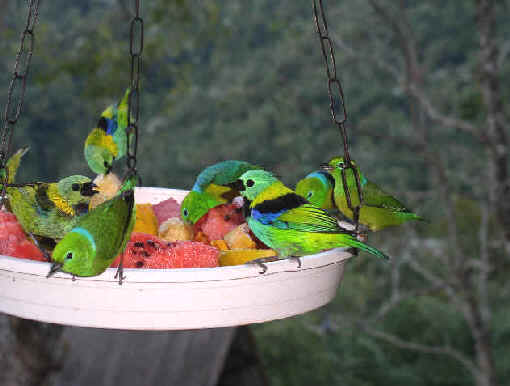
COLORFUL
BIRDS AT A FEEDER IN SOUTHEAST BRAZIL.
Green-headed Tanagers & Blue-naped Chlorophonias.
Both species have green heads.
The tanager has blue on the shoulders.
The chlorophonia has blue on its neck.
(Photo by Dan Coleman,
during the August 2007 FONT tour in Brazil)
FONT E-NEWS, August 2008: Our Tour in BRAZIL at Iguazu Falls & in Mato Grosso do Sul
PAST
TOUR HIGHLIGHTS: Our January 2008 JAPAN Tour with Blakiston's Fish Owl, Eagles, Cranes, Mandarins, &
More
FONT
E-NEWS, February 2008: Our Caribbean Tour in the LESSER ANTILLES on the islands
of St. Lucia, St. Vincent, Dominica
FONT E-NEWS, December 2007: A JAPAN tour with cranes, eagles, the Blakiston's Fish Owl, and more
PAST TOUR HIGHLIGHTS: Our November 2007 CHILE Tour from the Pacific to the High Andes
FONT E-NEWS, June 2007: In the Caribbean, the FONT PUERTO RICO Tour
FONT
E-NEWS, January 2007: Our Annual Winter JAPAN Birding & Nature Tour
FONT E-NEWS, February 2007: Our Holiday Tour in
GUATEMALA (Dec '06 - Jan '07)
PAST TOUR HIGHLIGHTS: Our October 2006 BRAZIL Tour in Minas Gerais & Rio Grande do Sul
A
Chronological List of Upcoming FONT Birding & Nature Tours
FONT Past Tour Highlights
Narratives & Photo Galleries relating to Past FONT Tours
![]()
FONT E-News, Volume 9, No. 11
November 14, 2008
from Focus On Nature Tours, Inc.
"The
FONT Birding & Nature Tour in Mexico in November 2008"
This was a tour in Mexico
with two "J"s - and with both of them during the same day: a Jabiru
& a Jaguar.
That morning, we saw closely a single Jabiru (it's a rare bird in
Mexico).
Later that day, at dusk, we saw a Jaguar. It too was close,
during our 5 minutes of observing it ahead of us on the road in the forest,
becoming even more so, as the big cat walked, with its steady pace, to be
immediately in front of our vehicle. There it was seen at every angle as it
turned to cross the road, and then walked away a short bit before disappearing into the
trees.
Another highlight of the tour was a beautiful Rufescent (or Thicket)
Tinamou that walked, with its determined pace, right by us, as we were on
the lower steps of a Mayan temple.
And yet another highlight was by yet another remote Mayan temple in the forest -
an Orange-breasted Falcon.
At the opposite (or northern) end of the Yucatan
Peninsula, during one day we saw thousands of birds. Over
20,000 of them were American Flamingos. Others, in the multitude that day
included thousands more of other kinds, with the assortment consisting of
waterbirds, shorebirds, and some landbirds too. Notable among the
last of these groups was a single hummingbird, known as the Mexican
Sheartail - a rare bird with a very restricted range that's actually only
about a kilometer wide.
Among the waterbirds, there were hundreds of American White Pelicans,
with many feeding in unison on the water of the bay. The number of shorebirds
were more than imaginable. In swarms, all around us, most were Lesser
Yellowlegs, Least Sandpipers, other peeps, and Sanderlings.
But there were others too, including a variety of Plovers: Snowy, Piping,
Wilson's, Semipalmated, and Black-bellied.
In the central Yucatan, a fascinating experience for us was in the "other
nature" category. Underground, in a pool of clear water in a cave, we
saw, with our flashlights, some Yucatanean endemic creatures that could never
see us. In that dark world, there were all-white: a fish, an eel,
and a shrimp, that do not have eyes!
Links:
List of Birds & Other Wildlife during our Mexico Tour - November 2008
List of Birds of the Yucatan Region of Mexico (with photos)
Upcoming FONT Birding & Nature Tours in Mexico & Central America
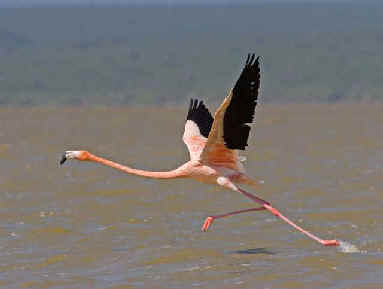
American Flamingo
During our November '08 Mexico Tour in the Yucatan,
we saw thousands of these beautiful creatures.
![]()
FONT E-News, Volume 9, No. 10
October 15, 2008
from Focus On Nature Tours, Inc.
"The FONT Birding
& Nature Tour in Iceland in Sep/Oct
'08"
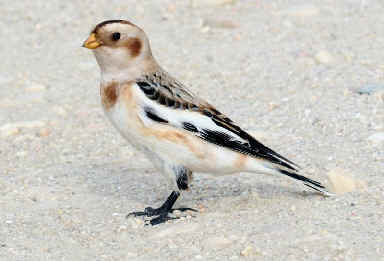
The Snow Bunting was one of the
landbirds
we saw in Iceland in the Fall of '08
During our week in Iceland, Sep 28 - Oct
6,
2008, there was so
much diversity in the nature that was around us.
Part of the country was still green,
with moss on volcanic rocks. There were rainbows and waterfalls.
And geysers and glaciers.
In the north, there was an early
snowfall. Above snow on the slopes of the hills, after dark, there were
beautiful displays in the sky of Aurora Borealis, or the Northern
Lights.
As white as the snow, was an Arctic Fox, close to us. Its nose and the
tips of its ears were black.
We saw at least 3 adult Gyrfalcons. One flew completely around us as we
were in our vehicle. A couple minutes later, it was chasing another Gyrfalcon.
The Ptarmigans that we saw were turning white.
Among other birds that were highlights were flocks of Barnacle Geese,
Harlequin Ducks, and Barrow's Goldeneyes.
This birding & nature tour was the 15th for FONT in Iceland.
During it, 5
new species of birds were added our cumulative list during tours in that country
(bringing it up to 101 species):
Buff-bellied (or American) Pipit (an
Icelandic rarity), American Black Duck, American Wigeon, Common Blackbird
(not at all common in Iceland), and Red Crossbill.
One morning, we
had an enjoyable time watching about 20 of the last of these, the crossbills,
along with about a dozen Eurasian Siskins, and many Redpolls.
There was a good crop of cones in the spruce trees. And, now, with more such
trees in Iceland, there are more birds there such as the crossbills and siskins.
Continue reading, if you would, about more of what we saw and experienced in Iceland during our 2008 fall
tour in that wonderful country for nature.
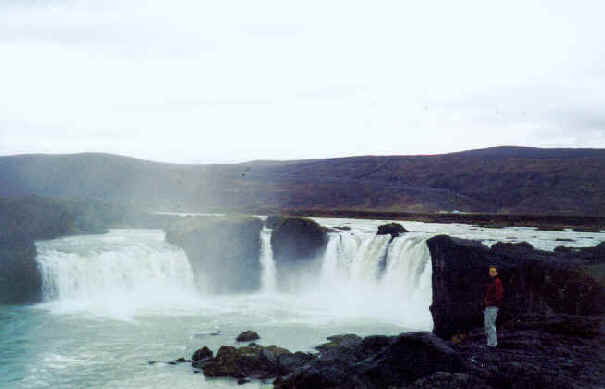
The waterfall known as "Godafoss",
one of a number that we saw in Iceland
during our Sep/Oct 2008 tour.
Links:
Birds during previous FONT Iceland Tours (with photos)
Complete
Iceland Bird-List
(over
350 species, including vagrants from mainland Europe, Asia, & North America)
Birds during previous FONT tours in Europe (with photos)
Upcoming FONT Birding & Nature Tours in Iceland
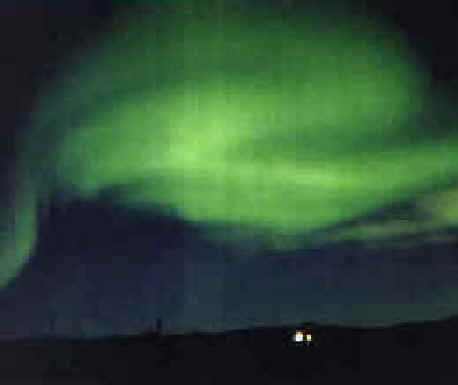
The Aurora
Borealis, or Northern Lights,
as we saw them so well, during our Sep/Oct 2008 tour in Iceland
The following narrative was written by Armas Hill, leader of the tour:
Iceland is
a beautiful place. There's no putting it any other way.
Oh, a day there with bad weather, especially in the late fall or winter, could
possibly be dreary and dark. But, if a day, just about anywhere in Iceland, is
clear, the scenery is, for lack of a better word, SPECTACULAR. In fact, it is,
actually, with mountains, cliffs, seacoast, waterfalls, and glaciers,
just about beyond words.
During our week-long, 15th tour in Iceland, September
28 to October 6, 2008,
the weather was, overall, good.
But during one afternoon and evening, the remnants of what had been, to the south, a
tropical storm and a hurricane, passed through. (That storm had actually
entered the northern US state of Maine as hurricane - a rare occurrence.) In
Iceland, there was, that day, some strong wind, and, as darkness fell, a light
snowfall. We were in northern Iceland at the time. The next morning, as we were
in the area of the large lake known as Myvatn,
there was another aspect added to our composite of 15 Iceland tours. The
countryside was, for the first time during one of our October tours, WHITE with
that first snowfall of the season. It was snow, the locals told us, that was
about a month early. But on that crisp, clear day, in that beautiful area, we
reveled in where we were - Iceland!
That morning, by the shore of the lake, a Gyrfalcon flew quickly by us,
in the pursuit of a Raven, as we drove along the empty road.
So, of course, we stopped. And, then that magnificent bird came back and circled
around our vehicle!
We were thrilled. We had just seen a wild, adult Gyrfalcon in Iceland,
without either looking for one or going to a particular place.
We've seen Gyrfalcons during our Iceland tours in the past, but often (although
not always) they've been at places where we expected that "target
bird" to be.
So, happy as we already were, we continued along that lakeside road. And then,
moments later, outside the window of our vehicle, I heard a Gyrfalcon's
call. Looking left, we saw it - in flight, chasing another bird - another Gyrfalcon!
For a few wonderful moments, we saw the two magnificent, large falcons
flying about in the sky - the chaser, calling as it went, and the other Gyrfalcon
being chased. Those wonderful moments made it a wonderful morning, long to
be remembered.
A couple days later, with a clear blue sky above us, and with snow still on the
ground, yet another Gyrfalcon was seen.
Late in the afternoon, as we traveled along a road by a very picturesque stretch
of the north coast, a Raven was noticed as it was perched on the ledge of
a cliff. To the left of it, there was another bird on another cliff-top ledge -
but, no, it was not another Raven. Rather, it was our third adult Gyrfalcon
of the tour! As it was rather close, we saw it quite well, before it quickly
flew away.
And so, during our Sep/Oct '08 Iceland tour, we saw the most adult Gyrfalcons
seen during any of our tours.
We have seen three (or more) Gyrfalcons previously - during a
May/Jun tour: adult male & female, with a chick (or two) on a nest.
Our Sep/Oct '08 Iceland tour was also distinctive in that during it we saw 3
species of falcons. That's hard to do, as two such species regularly occur
in Iceland.
But, early in the tour, as we were traveling along a road by the south coast, we
saw a Common (or Eurasian) Kestrel. That
species is a rarity in Iceland. First, we saw it on a fence post close to the
road. Then, the bird, a female, flew toward us and continued in flight above a
field on the opposite side of the road. We watched it fly for a while, as it
pursued a Raven.
That Kestrel was just one of the avian vagrants that we saw in Iceland in
Sep/Oct '08. There will be more about others later in this narrative.
The third species of falcon of our tour was the other that occurs
regularly in Iceland - the Merlin. We saw at least one (usually in
flight, but sometimes perched) every day, except one, during the tour.
You may have noticed that Ravens have been mentioned as being near two of
the Gyrfalcons and the Kestrel just noted. When something
"good" was found, Ravens seemed to be "there".
That happened, also, when we had certainly what was one of the best sightings of
the tour. We were traveling in the morning, along the road, noted a moment ago,
by the picturesque north coast (where later in the day we saw our third Gyrfalcon).
An all-white animal, with a bounce to its fast walk, was seen to the left of
the road ahead of us. A couple Ravens dove at it from above. The animal
was an Arctic Fox, one of the very few species of land animals that occur
in Iceland. (Others, such as the Reindeer that we saw, were
introduced.)
We drove further, until the fox was just outside the window of our
vehicle, only a few feet away. What a beautiful creature, that all-white Arctic
Fox was to see - as we looked at it, looking back at us! All of its fur was
white. Only its nose and the tips of its ears were black.
In Iceland, there are two distinct color forms of the Arctic Fox.
The "blue" variety, which comprises about two-thirds of the
population, is a chocolate-brown in the summer, and a lighter shade of brown,
tinged with a blue sheen, in the winter.
The "white" variety is a spectacular pure white color in the
winter, molting to a gray upper coat and light-gray to white underside in the
summer.
It was, as noted, the "white" variety that we saw so nicely. And
already, in October, it was in its winter attire.
The foxes of the two varieties in Iceland interbreed freely, but their
offspring are either "blue" or "white" - there is no
intermediate.
Also interesting about the Arctic Fox is its adaptation to the cold, in
order to survive the far-northern winter.
The Arctic Fox is smaller than the widespread Red Fox of the
temperate zones. The winter coat of the Arctic Fox is very thick, with
plenty of underfur, in comparison to its more lightweight summer coat. The broad
paws of the Arctic Fox have long fur on the bottom for protection from
the cold. In all, the adaptation is so good that it enables the Arctic Fox not
only to survive, but even not to shiver until it's been at minus 70 degrees
Centigrade for an hour!
Another
spectacular white animal of the Arctic was seen in Iceland, along the
picturesque north coast, earlier during the year in 2008.
Actually, there were two Polar Bears, both appearing there in the
month of June, the first on June 3, and another on June 16. Over the years,
there have been such occurrences in Iceland, of these animals coming on floating
ice from the north, but not many.
In October 2008, during our Iceland tour, we spent the night in the small
fishing town closest to the first '08 Polar Bear appearance. We stayed,
there, in the oldest hotel in Iceland. During the 1800s, the wood for that
structure came by ship from Norway.
Later, the next day, just a short distance south of the Arctic
Circle,
we looked across a fjord to where the second known Polar Bear in '08 had
appeared in Iceland.
We were on our way to an isolated, remote homestead along that north coast,
where, from what we had learned on the internet, a Scarlet Rosefinch,
from Siberia, appeared a couple days earlier in a very small fenced-in garden by
the sea, with cabbage and a few bushes.
That bird was no longer there when we were. But it was interesting to meet, at
the door of the house, the young man and his son younger yet. Behind him, I
could see the computer that had been used to put out the word into cyberspace of
that little bird from came to Iceland from Asia.
Again, as I noted a bit ago, there will be more, later in this narrative about
avian vagrants in Iceland.
The previous night, in the small fishing town and outside the front of the old
hotel, just mentioned, there was, for me, an interesting occurrence.
I had just gone out the front door and down the steps to the parking lot, to
look up above in the sky at the dancing Northern
Lights,
or "Aurora
Borealis".
I also saw, at that time, a small bird fly past above me, by a spotlight shining
from the corner of the old wooden hotel. The bird was about the size of a
sparrow. Of course, there are no sparrows, normally, in that part of the world.
And while maybe a Snow Bunting, or even a Lapland Longspur, could
be, earlier that day, and the next day, no such birds were seen by us anywhere
in that area.
Nor were there, in that area, any Redpolls. We saw many in other parts of
Iceland, but not in that region.
Small birds that are vagrants in Iceland in the fall, such as the Scarlet
Rosefinch at about that time in the little garden along the nearby coast,
travel in the darkness of night.
I could wonder what that little bird was, flying by at night in the light that
shone from the historic hotel, beneath the green lights, high in the sky, of the
Aurora
Borealis.
The identity of that little wanderer would never be known.
Another wanderer that also appeared along that picturesque northern Icelandic
coast earlier in 2008 was a bull Walrus that came ashore on August 7.
Such an occurrence was not unprecedented in Iceland, but it is rare.
During our time, in Sep/Oct '08, along the north coast of Iceland, we saw
no Walrus, as we saw no Polar Bears, but we did enjoy seeing the large Gray
Seals that were either basking along the rocky shore, or floating on the
water like huge cucumbers, with their heads elevated at one end, and their
flippers elevated at the other.
Earlier, during our tour, we had seen Harbor Seals, with their heads
poking out of the still water of a large pool in front of Europe's largest
glacier.
The long, northern Icelandic coast, to which I've been referring, is rather like
the coast of the Maine in the US, in that if it were to be stretched into a
straight line, it would be VERY LONG. I couldn't help but think how much
territory there was for vagrants such as Polar Bears, Walruses, and Scarlet
Rosefinches to appear - and especially to be at places where no human being
would be present to see them.
What was present along that northern Icelandic coastline, and certainly more so
than expected, were large pieces of driftwood - as big as large tree trunks in
forest that does not occur anywhere in Iceland.
The wood for the old Icelandic hotel, as already noted, was brought by ship from
Norway years ago. But the driftwood, as large as tree-trunks, came on its own -
possibly, also, from Norway (although, from where we were, looking out to sea
from shore, we were looking toward Greenland - where also there are no large
trees).
Such as it is, and was for us, along that, once again, picturesque north coast
of Iceland.
Early in this narrative, it was noted that a day with bad weather in Iceland
during the late-fall or winter could be "dreary and dark". None of our
days, during the Sep/Oct
'08 FONT Tour,
were that way.
Actually, during late September and October, the days in Iceland are with just
under 12 hours of daylight, from just after 7am to about 7pm. At that time of
year, soon after the equinox, it's about midway between the long days of the
Icelandic summer and the short ones of their winter.
Also, during October, over the years that we've done tours in Iceland, we've
found that clear nights, about 3 hours after sunset, to be particularly good for
fine displays of the Northern
Lights,
or Aurora
Borealis.
During our Fall 2008 tour, during a couple nights, we enjoyed such displays that
were especially good. One of those nights, we were at a hotel very much out in
the countryside, with no city lights near us at all, and with fine visibility in
all directions. After a marvelous sunset, the planets and stars got increasingly
bright. And then, later that night, at that hotel, even from the windows of our
warm rooms, with the lights turned off, we saw very well a sky that was filled
with the dancing displays of the bright green aurora. Toward the horizon around
us, there were gentle slopes, covered with snow, that added to the beauty of the
night with the aurora.
In addition to the beautiful, and even spectacular, Icelandic scenery that's
been referred to, and other aspects of our Sep/Oct
'08 Tour
noted thus far, there's yet another feature of a nature & birding tour in
Iceland in the fall, that's most significant. Put simply, the country is
INTERESTING.
Of course, the various geological features are - including the fields of lava,
volcanic cones, geysers, and the Mid-Atlantic Rift.
In narratives of our previous Iceland tours, that rift has always been mentioned
- and that's because it's always of interest.
In Iceland, the crack (widening, they say, at about an inch a year), with
"America" to the west and "Eurasia" to the east, is "on
land". Elsewhere, throughout the Northern & Southern Hemispheres it is
on the ocean floor.
And, for birding,
late September and
early
October
in Iceland is extremely INTERESTING.
That's because so many species of birds can possibly be seen.
You may have noticed the link above to the "Complete Iceland Bird-List, of
over 350 species".
In that list, about 70 species are regular, and mostly common, breeders in the
summer.
Another dozen or so birds are migrants that are more or less regular.
Another 30 species or so, occur, in most cases, annually, but uncommonly.
And then there are about 275 bird species that have been found in Iceland, over
the years, as vagrants. These come from not only the European mainland,
but also from as far east as Siberia, and from the opposite direction, from
further south, in North America - and, yes, even from the south in the fall.
The months of September and October are particularly good for such vagrants.
And, with the network of bird reports that's on the internet in Iceland,
visiting birders (such as us), can readily be aware of what's been
sighted - where & when. This element of "expecting the unexpected"
adds to the excitement of our fall Iceland tours (as if more excitement
really needs to be added!).
During the days of our Fall
2008 Iceland Tour,
and just previously, these avian vagrants were noted in Iceland:
From
North America: Canada
Goose, American Black Duck, American Wigeon, White-rumped Sandpiper,
Buff-breasted Sandpiper, Ring-billed Gull, Red-eyed Vireo, Buff-bellied
(or American) Pipits.
From
Europe and/or Asia: Red-necked
Grebe, Little Egret, Rough-legged Buzzard, Curlew Sandpiper, Blackcap, Eurasian
Reed Warbler, Wood Warbler, Barred Warbler, Eastern Olivaceous Warbler (a
first for Iceland), Common Chiffchaff, Citrine Wagtail, Common
Rosefinch, Lapland Longspurs (could be from Canada, but maybe
Lapland Longspurs from Lapland)
And from
"wherever":
a Cattle Egret and an Osprey.
Of course, we didn't see all of these, but we did see some.
During our first day in Iceland, at the tip of a peninsula, where a number of
birds can funnel through, we observed the two Buff-bellied (or American)
Pipits, that had been there for a couple days, walking about on the
ground near our feet.
Another facet of that story is that there was also a birder about there, who
looked somewhat familiar to us. Speaking with him, we learned he lived in Norway
- and was returning to his home country, by way of Iceland, having flown, as we
just had, on Icelandair from North America.
He had just been, for a week, at an American birding hot-spot, where we also
were, prior to Iceland - Cape May, New Jersey. It was there where we had seen
him, at the Cape May hawk-watch platform - and that's why he looked familiar!
But about those two Buff-bellied (or American) Pipits:
they had come to that spot in Iceland from North America on their own, even
without Icelandair (the only airline that flies from North America to
Iceland).
Those pipits were said to represent the 16th record for that species in
Iceland. Just a couple years ago, it was said that there were only 6 records.
Probably, the actual number of American Pipits has not increased to such
a degree. Rather, the species could have been overlooked, with now, more people
aware of how to do the ID. After all, who would have looked so closely at two
such similar pipits, the other being the Meadow Pipit, the most
common passerine in Iceland. Meadow Pipits generally leave Iceland in
September.
In addition to the American Pipits, other species we saw during the tour,
unusual for Iceland, included: American Black Duck and American Wigeon.
The American Wigeon, by the way, was bird number 101 in the FONT
cumulative list for Iceland.
During the fourth day of our tour, when still in the southeastern part of the
island, (and prior to the snow), we enjoyed one of our best lunches of
local Icelandic specialties in a little restaurant in a small, remote fishing
town along the coast. The lady there enthusiastically told us of a bird
sanctuary on the edge of town by the bay. So, after our lunch, we visited the
nice place. The next day, on the computer, we learned that on the day before our
visit to that sanctuary, a Little Egret had been spotted there. As nice
as the place was, it would have been nicer had we been there one day earlier and
seen yet another Icelandic rarity.
Also in southeastern Iceland, we learned, when we were in the area, that a Cattle
Egret had been found. It was the 3rd record for that species for Iceland. We
looked, as we passed by fields, with mostly Icelandic Sheep and Icelandic
Horses, but we didn't see the wayward, or lost, egret.
That bird, we understood, was not far from the large expanse of snow covering
the large glacier in that part of Iceland. As far I know, that's about as far
north as a Cattle Egret has ever been found.
As we traveled along, scanning the fields for the bird, I remembered reading
that the southernmost record of a Cattle Egret in the world was on the
Antarctic Peninsula (also near snow, I presume) at 65 degrees south.
Where we were in Iceland was at about 66 degrees north. The Arctic
Circle is
just a portion of 1 degree beyond that latitude.
When we were in northern Iceland, a few times we crossed the 66-degree line. Two
of our lunches were at places north of 66 degrees. We never slept north of that
line, but we did stay at hotels just a very few miles south of it.
Also, along the northern Icelandic coast, we traveled along a road, at the north
end of a peninsula, as close as any road goes toward the Arctic
Circle.
To get to the invisible circle itself, we would have had to go only a few miles
further out to sea. The birds that we saw, there, closest to the Arctic
Circle were
Ravens, and both Glaucous and Iceland Gulls.
As for these Iceland Gulls in Iceland, they actually had come from
further north. In the summer, they breed in Greenland. They don't nest in
Iceland, only coming there in the fall, to stay until spring.
With reference as there's been here to the Arctic
Circle
and snow, one might think of Iceland as being very cold. Actually, during our
tour, it wasn't.
Remember, too, that in addition to Iceland being close to the Arctic
Circle,
it's also relatively close, on its south side, to something else - the Gulf
Stream,
which warms up western and northern Europe.
At the end of our tour, we all wrote on pieces of paper some of the highlights
of what we had seen in Iceland.
Even if there had been no birds that were vagrants or rare in Iceland, there
still would have been many highlights, as there are so many notable
facets of the nature, and particularly the bird-life in Iceland, with the
backdrop of the spectacular scenery and the interesting natural features that
have already been noted.
Included in everyone's lists of highlights were the already-mentioned all-white Arctic
Fox, the 3 Gyrfalcons, and the brilliant Northern Lights.
Also noted were the following:
There were flocks of Barnacle Geese, having come from Greenland, before
continuing to the British Isles. Those flocks were in southeastern Iceland,
where not many other birds are found, in a vast area of fluvio-glacial outwash
plains.
In that area, at another time of the year, there is the world's largest breeding
population of Great Skuas, and they too, pretty much have that stony
region to themselves.
The strikingly beautiful Barnacle Goose that we saw in Iceland in
September were often along picturesque glacial streams.
That was in contrast with the many flocks of Greylag Geese that we saw,
as they often were on cultivated fields.
The one sizable flock we saw of Pink-footed Geese was interesting. It
was, in a tight group, first in flight and then resting on the water out toward
the center of the large Lake
Myvatn.
Also in that part of Iceland, near Lake
Myvatn,
we enjoyed seeing large groups of Barrow's Goldeneyes, both males and
females, on a rushing river, riding the rapids.
A few female Harlequin Ducks were also there, but not many. Nearly all of
the Harlequins that frequent that stretch of fast water in the summer,
had left for the seacoast.
That is where we saw tight flocks of them, usually in segregated groups of males
and females. In the sunlight, such a group of colorful males was a superb sight.

A flock of male Harlequin
Ducks
We
seemed always to be seeing Ravens. Mention has been made of them being
present by a Fox, a Gryfalcon, and a Kestrel, and as close
as we got to the Arctic
Circle.
But even with their own kind, Ravens were good to see. They were often in
pairs, and when they were acrobatically flying together in the sky, yes, they
were a great sight.
It took us a while to see Ptarmigan. But, on our last day, in the
morning, they were there! - on a dirt front, in front of us, only a few feet
away - and just standing there. They were turning white, and I guess had we'd
had been able to watch them for a longer time, we would have seen them do so, a
bit more, from brown to white!
Also that morning, in a grove of conifers, we walked about in a "
fantasy-forest" of sorts that was loaded with birds - mostly Redwings
and Redpolls, but also with some yellowish Eurasian Siskins, a Goldcrest
or two, and a wonderful flock of over 20 Red Crossbills.
The tops of the spruce trees in that forest were filled with cones, and it was
great to watch, in particular, the crossbills feasting on them. Both male
and female adult, as well as immature, crossbills were nicely seen.
A note that should be made is that during recent years a sizable number of trees
have been planted in Iceland. New forests have sprung up throughout the country.
The forest where we observed so well the crossbills with the cones was a
bit more established. During early FONT tours in Iceland, in the 1990s, it was
one of the few forests we encountered.
With the increase in coniferous forests in Iceland, the face of Icelandic
landbirding is changing, with a corresponding increase in birds such as Goldcrests,
Siskins, and Crossbills.
Not long ago, Goldcrests and Siskins were not known to breed in
Iceland.
The Red Crossbill is known to have bred in Iceland only once - oddly
during the dark, wintry month of DECEMBER, in 1994.
Earlier during our Sep/Oct
'08 Tour,
we visited the old cemetery in the only large city in Iceland, Reykjavik.
It's another place that's been filled with trees for years, and those trees,
when we were there, were filled with food for birds, both cones and red berries.
And so it was that the spot was filled with birds - many Redwings and Redpolls,
and also some Siskins.
The Redwing is, of course, a thrush, in the same genus as the American
Robin. We saw another Turdus thrush in the trees and bushes in the
cemetery - the Common Blackbird, a bird that's common in mainland Europe,
but not so in Iceland. It was first found to nest in Reykjavik
in 1969,
and has done so regularly (but only in small numbers) since 1991.
At one place in particular when we were in northern Iceland, during the morning
after the first snowfall, we came across a grove of trees in which there were
hundreds, probably more than a thousand, Redwings. They were feeding,
furiously, on thousands of red berries. It's said that "if you find the
restaurant, you find the birds".
Those Redwings, gathered in a large group, were fueling up before the
migration to their wintering grounds in England and elsewhere in western Europe.

A Redwing
A
bird, never in a flock, that we saw a few times during the tour was the Common
Snipe, either springing up rapidly from the ground, or flying by us quickly.
As the Arctic Fox, that we saw, bounced along under pestering Ravens,
it flushed a Snipe into the air.
Already mentioned among unusual birds for Iceland that we saw, have been: the American
Pipit, American Black Duck, American Wigeon, Common Kestrel, Common Blackbird,
Goldcrest, Eurasian Siskin, and Red Crossbill.
In all, because of birds such as these, 65 species of birds were tallied during
our Sep/Oct
2008 Tour.
That's the most bird species we've seen during any FONT Iceland tour in the
fall.
Additionally, in that total, were 3 Grey Herons that we saw at a days-end
along a stream. That species flies to Iceland at summers-end from Norway.
Also we saw, for the first time during any one FONT Iceland Tour, two species of
Godwits, both Black-tailed and Bar-tailed. The first of
these species breeds in Iceland. It's an endemic subspecies, notable due to its
richer coloration. Most leave Iceland by September. The second of these species,
the Bar-tailed Godwit, arrives in Iceland in September, from where it
breeds, in Norway.
The attractive little town, in the southeast
Iceland,
where we saw the mixed flock of about a half-dozen godwits, is located on
a spit of land along the coast.
Not only is the town attractive, its environs are as well, with, on clear days,
as they were for us, a wonderful panoramas was visible of mountains and glaciers
in the distance, above the blue water of a big bay.
That town is a good place, from what we've read, for avian vagrants to arrive in
Iceland, having come in from over the ocean, even into the smallest of groves of
trees and bushes.
In addition to seeing the godwits there, we had another noteworthy
experience in that town.
From the window of a restaurant (yes, another place where we had lunch!),
we saw on the lawn outside, a boldly-patterned bird - a single Eurasian
Oystercatcher. It was eating (also, as we were), but a very different
meal - one worm after another. One could have more aptly have called it a "Eurasian
Worm-catcher".
Later, near the tour's end, we were to see hundreds of Oystercatchers,
more appropriately, along the rocky coastline of a fjord, where there were also Purple
Sandpipers, Ruddy Turnstones, and some European Golden Plovers.
The Golden Plover we had seen, in flocks, throughout the tour, and
throughout Iceland, in the north and the south, and in the east and west of the
country.
Did I mention that, during the tour, we traveled just about the entire "Ring
Road", doing a loop, counter-clockwise, around the island?
As we were on that road, in the central highlands, we were treated to a couple
large flocks of Snow Buntings.
In the southeast, we saw thousands of Northern Fulmars, either sitting on
or flying about cliff-faces, and often in flight by waterfalls.
In the southwest, we liked seeing big rafts of Common Eiders, including
in them numbers of adult males in full breeding plumage.
The Common Eider is the largest duck in Iceland, and it is also
the most common of the many ducks in Iceland.
In southern Iceland, we stopped at a seaside cliff where in the summer, there
are many Atlantic Puffins. During that season, like the eider
and fulmar, the puffin is among the most common of all Icelandic
birds.
But, it is not common there after the breeding season. Most go out to sea.
From that cliff, in late September, however, we were fortunate to see a few
lingering puffins in a couple flocks, bobbing about, along with ducks,
in the waves.
After their breeding season, we could see that the puffins' notable beaks
are not as large, nor as red, as they would be in the summer.
And so, much of what we saw, as we circled Iceland in Sep/Oct
'08, was
great to see.
But, maybe most memorable, was what we saw in southeast Iceland, at a cove along
the coast, where, during one sunny morning, at least a thousand Whooper Swans
were gathered on the water and by the shoreline. We were fortunate to be
there when the swans were. They had come from throughout much of Iceland
to that particular spot to stage before flying to Ireland for the winter.
Yes, that day, as we and the swans were there, along the Icelandic coast,
the sun was shining on those large white birds.
But only a few miles away, in the hills, there were clouds from which some rain
was falling.
And so it was that those Whooper Swans, at the cove, were at the bottom
of a bold and beautiful rainbow, with a backdrop of green hills and white
glaciers.
It truly was a magnificent sight and setting - with only the sounds of swans,
and no other noise.
When we there, with such beauty and peace, we knew that it really was a
wonderful place to be.
Overall, however, it could well be said that throughout our trip, we found ALL
of Iceland to be a wonderful place, where the fine group of people who were on
our late
Sep/early Oct '08 Tour,
had, surely, a good and memorable time.
![]()
FONT E-News, Volume 9, No. 9
September 6, 2008
from Focus On Nature Tours, Inc.
"The FONT Birding
& Nature Tour in southern Arizona
& northern Mexico in Aug/Sep '08"
During the first
part of this tour, in ARIZONA, a bird, normally of Mexico, was both seen and
heard. That bird, a FIRST for the United States, was the Sinola Wren (formerly
known as the Bar-vented Wren). Its new name is that of the
Mexican state that's located south of the more-northerly Mexican state of
Sonora, which borders on Arizona.
During the second part of this tour, during 3 days, we were in SONORA, MEXICO,
where, at a remote ranch, we birded and explored in some of the most pristine
countryside imaginable. Among our "Mexican" bird species there, in
addition to another Sinola Wren, there was, in the riparian plants at the
base of a magnificent canyon, the Rufous-capped Warbler.
During the ARIZONA portion of the tour, as usual as during our previous tours,
we enjoyed a wonderful assortment of Hummingbirds, including a couple
species that are more common in Mexico, the White-eared, the
Violet-crowned, and the Lucifer.
In addition to birds, during this tour, there was a fine assortment of butterflies,
mammals, and reptiles.
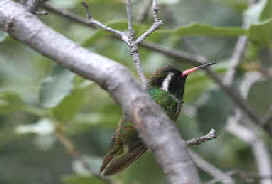
White-eared Hummingbird
Links:
Birds
& Other Wildlife during our southern Arizona & northern Mexico Tour in
Aug-Sep '08
Cumulative
List of Birds during FONT Arizona Tours (with photos)
A List & Photo Gallery of Mexico Birds, in 3 parts:
Part #1: Tinamous to
Shorebirds
Part #2: Jaegers to Woodpeckers
Part #3: Manakins to Buntings
Mammals
during FONT Arizona Tours (with
some photos)
Mammals
of Mexico (with some photos)
Upcoming FONT Birding & Nature Tours in Arizona
Upcoming FONT Birding & Nature Tours in Mexico
![]()
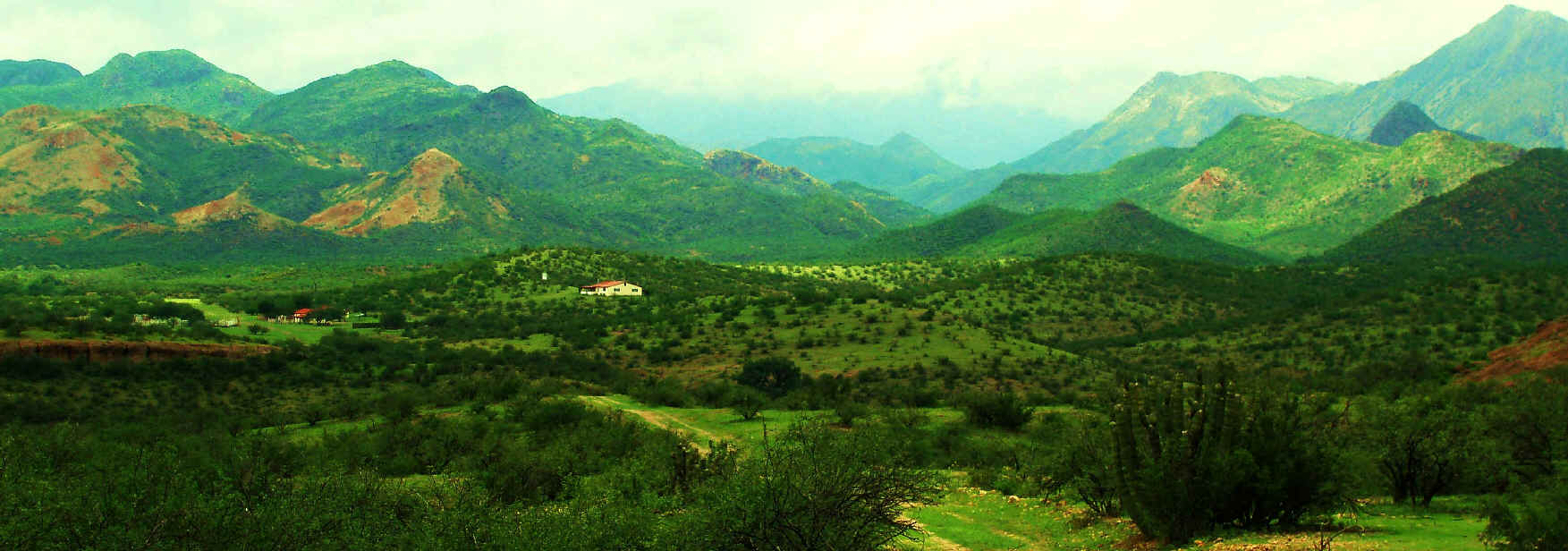
It was in the
building on the hill with the red roof
where we stayed during our days & nights
in remote eastern Sonora in northern Mexico
during our tour in September 2008.
Birds in the area included: Montezuma and
Elegant Quails,
Zone-tailed Hawk, Rose-throated Becard,
Sinaloa Wren, Rufous-capped Warbler,
Mexican Yellow Grosbeak, Five-striped Sparrow,
and both Rufous-winged &
Rufous-crowned Sparrows.
Pumas
are said to be common in the area as are
White-nosed Coatis &
Collared Peccaries.
We saw a number of Coue's White-tailed Deer,
Antelope Jackrabbits,
and various bats.
Early in the mornings, Coyotes
howled close to where we stayed,
actually just outside our windows.
At dusk, Common Poorwills
called, even though it was early September.
After dark, in the completely-clear sky, there was a superb show
of stars & planets,
with a brilliant Milky Way
that stretched from nearly horizon to horizon.
A couple very bright "falling
stars" were also in the
cast of celestial characters.
This was as some Elf Owls
called, even though, again,
it was September.
Below is another view from elsewhere on the property
where we stayed in Sonora, Mexico in September 2008.
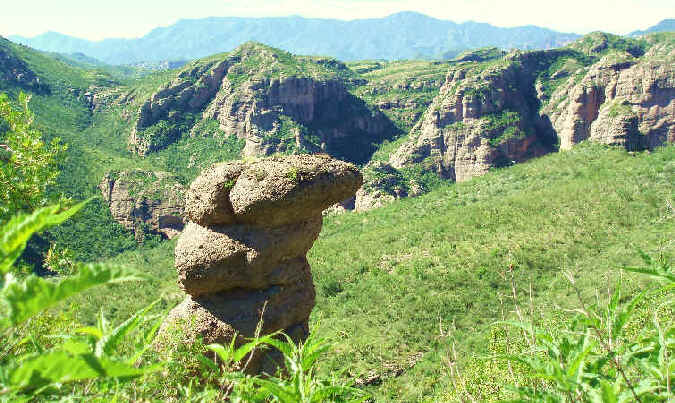
The following narrative was written by Armas Hill, leader of the tour:
For
a number of years, during the second half of the summer, FONT has been going to Arizona, primarily to see the
hummingbirds that also go to that state at that
time, but also other birds too. In all, nearly 150 species of birds have been
seen during the FONT tours in Arizona in the late-summer.
In 2008, this annual tour was a little later that it was other years. It was at
the very end of August, and spilled into
September. The dates were
August 28 to
September 4, 2008.
Being later, and further into the migration, a few species were seen in Arizona
for us for the first time. Among them, the MacGillivray's Warbler was
particularly common. There were a couple Sparrow species that we had not seen,
other years, when the tour was earlier, the Savannah and Vesper. A single
Osprey
in a treetop at a day's end, no where near water, was also "new" for
us for Arizona. And there were two species that we saw that normally range east
of Arizona, the Northern Parula and the Yellow-throated Vireo.
But one of our "new" bird species for Arizona
was especially notable.
It was a species not ever seen, not only by us, but by anyone, prior to the end
of August 2008, not only in Arizona but anywhere north of Mexico, where the bird
is endemic. Seeing a "new species" for the US, or for North America
north of the Mexican border, is a hard to do!
In all, over 800 species of birds have been noted in North America as just
defined - that is, North America north of Mexico. Of those, over 700 species are
regular, either widespread or local, in that part of the continent north of
Mexico. Others are vagrants, that have occurred either at sea, or usually at the
edge of the land mass, in remote places such as Alaska and Newfoundland. Other
rarities for the region have also been at or near its edge, in Texas, New
Mexico, Arizona, and California.
The particular bird, being referred to here, as being in
Arizona, is a
wren.
It's named for a Mexican
state, Sinaloa, although the species also occurs in a
state that's further north and closer to the US, that is the border state of
Sonora.
The wren, now known as the Sinaloa Wren, was formerly called the Bar-vented
Wren. It's a Mexican endemic (even with the new Arizona occurrence
notwithstanding).
Mexico is a country rich in wrens. 29 species occur. That's more than in any
other country. Among them, 11 are endemic to Mexico: the Gray-barred, Giant,
Spotted, Boucard's, Yucatan, Sumichrast's, Nava's, Happy, Socorro, and the Clarion, in addition to the
Sinaloa.
Putting all them together would be quite a collection of song. Putting all 29
Mexican species together would be a symphonic blast!
Incidentally, in addition to the Sinaloa Wren (as noted, just found in Arizona),
there are 2 other wren species that occur regularly and in numbers in Sonora and
have not been found north of the border: the Spotted and the Happy
Wrens, with
the former not yet "spotted", and the latter apparently happy to be
where it is.
We went during two consecutive mornings to the place with that first Sinaloa
Wren visiting north of the Mexican border. Both of those mornings, there were
numerous birders, from a variety of places themselves, hoping to get a look at
the bird. Most, those two mornings, did not. A few heard the bird, giving its
call, or a bit of a song, in the distance. Some got but a glimpse. Our
experience was like that. On the other side of a stream, the call-note of the
Sinaloa Wren was heard. Two wrens were detected in the underbrush. But when one
appeared. it was a Bewick's Wren. Birds of the two species were apparently
associating together.
So, we decided to go back again - later during our tour, on our way back from
the Chiricahua Mountains back to
Tucson. It would not be at what would normally
be thought of as the best time in the morning, and there probably would not be a
crowd of other birders, but even so, we decided to visit the place again.
That place, by the way, was just south of the town of Patagonia, along a dirt
road near the sanctuary of the Nature Conservancy. That's where the bird had
been since it was found.
We learned about the wren, by the way, during our visit on the first day of our
tour, at the store and office of the Tucson Audubon
Society, where we always
stop for a visit at the beginning of our tours in the area. It was kind of them,
at Tucson Audubon, to tell us, right away, about the rarity, found the previous
day, that was a first, as noted, not only for southern Arizona, but for North
America north of Mexico.
Anyway, when we went back to the wren's favored site that afternoon, a couple
days after our previous two morning visits, we were most fortunate! It was about
3:45pm. As we drove slowly, along the dirt road, I heard some sounds of bird
activity in trees at what certainly turned out to be the right place. We saw,
first, some Bridled Titmice, and then the Northern Parula that had been seen by
others and by us during the mornings a few days earlier.
But wrens were detected in the underbrush. One or two Bewick's Wrens were
present. And then we heard the call, as we had a few days previously, of the
Sinaloa Wren. But not only that, then the bird came out onto the dirt road and
took a dust bath right in front of us! Of course, we saw it well. But yet there
was to be more. The Sinaloa Wren then went onto a branch, at about eye-level,
only yards from us, and sang its hearty song. We saw every feature of the
bird.
There's an expression that "it's not over until the fat lady sings".
Well, it was over for us, after that little Sinaloa Wren from Mexico belted out
its rich song in front of us in clear view! It was certainly the "right
way" to see a "good bird"!
There were some other birds that were seen nicely during our Arizona tour in
August/September '08.
The cast of sparrows one day was pretty good, east of Patagonia in the scenic
San Rafael Valley. That day we saw:
Cassin's, Botteri's, Grasshopper, Vesper,
Lark, Song, and Savannah. The last of these arrives in southern Arizona in
August. A number of sparrows and related birds, and an assortment of hawks
winter in that picturesque valley. During our day there, a notable raptor for us
was a White-tailed Kite.
And of course there were, during our 2008 Arizona
Tour, the
Hummingbirds! We saw
a dozen species, in various plumages, and all of them we saw
well. There were, of course, the regulars, including: the Broad-billed, the
"Rivoli's" form of the Magnificent, the Blue-throated, the
Anna's, the Black-chinned, the Broad-tailed, and the Rufous. Telling some
Rufous
Hummingbirds from the Allen's Hummingbird can be problematic, but we saw both.
And we also saw nicely the Calliope Hummingbird, the smallest of all North
American birds.
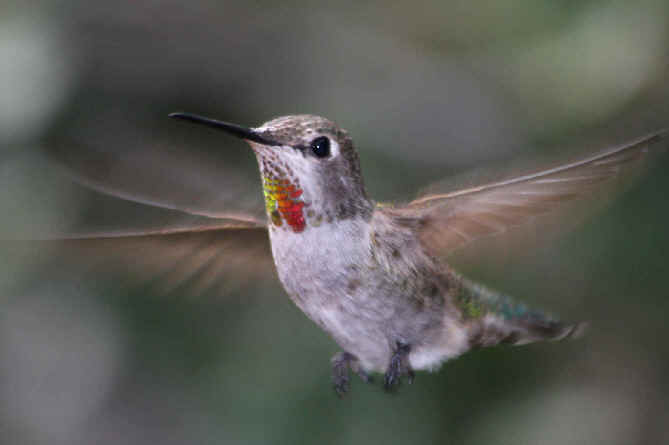
This fine photograph of an immature Broad-tailed
Hummingbird
was taken during the FONT tour in southern Arizona in August 2008
by tour participant, Doris Potter.
As our tour continued, we crossed the border from the
We headed toward a place that was to be special to us, for the birds
and the other nature that we would experience there. It's the property of a
large ranch, about 30,000 acres, in the
Wildlife does abound in the area. Pumas are said to be common.
Deer and Coyote are as well. Many birds occur. During our
tour, both Montezuma and Elegant Quail were found. In one of the
canyons, we found Rufous-capped Warblers. A Mexican Yellow Grosbeak was
seen, as were Five-striped and Rufous-winged Sparrows. The last of
these species can be seen locally in southern
In all, we saw a good number of birds, of about 70 species, on and near the
property of the ranch.
What probably is best about where we were in the remote hills of Sonora is that
it IS NOW, as places such as Arizona WERE in the past - before the
"development" brought highways, agriculture, and many people. On the
property in
Oh, there are some cattle on the ranch, but not many. As one traveled about on
the property on tracks in a four-wheel drive vehicle, one had the opportunity to
sense, during our visit, what a "natural place" could really be like -
and how it was before the highways, agriculture, and many people.
I thought, more than once, as I was in those Sonoran hills, that a place in the
There are a lot of birds and other nature in those Sonoran
hills. One of the more notable of the birds is the Mexican
subspecies of the Wild Turkey, known as the "Gould's
At one point, as we were driving, we noted a huge flock of birds kettling in the
sky, hundreds of them, maybe a thousand. A look in the binoculars showed them to
be Ravens.
Also in the region, numerous birds occur at
![]()
FONT E-News, Volume 9, No. 8
August 2008
from Focus On Nature Tours, Inc.
Brazil
(Southeast
Brazil, Iguacu Falls & Mato Grosso do Sul)
& nearby Argentina & Paraguay
July-August 2008
Again, during this
FONT tour in Brazil, our 43rd, a nice
assortment of birds & animals were seen. Also, particularly in the
area of Iguacu Falls, there was a tremendous variety of butterflies.
Among the mammals during the tour, highlights included: a wonderful look
at a Brazilian Tapir, as many as 7 Giant Anteaters in one day (including
a mother with a young animal on its back), a fine look at an Ocelot,
and two Giant Otters seen very well.
Nearly 300 species of birds were found.
Among the last of them, on August 18th, on the grass at the airport in Campo
Grande, there was, in addition to Red-winged Tinamous, an Upland
Sandpiper, having just flown in from North America.
On a nearby wire, that day, there were 3 Purple Martins, also having just
come from North America.
Links:
List of Birds & Other Wildlife during our Brazil Tour - July/August '08
Birds in Mato Grosso do Sul (with photos)
Birds in Southeast Brazil (with photos)
Butterflies of Brazil & Argentina, including those at Iguazu Falls (with photos)
Upcoming FONT Birding & Nature Tours in Brazil
![]()
FONT E-News, Volume 9, No. 7
July 7, 2008
from Focus On Nature Tours, Inc.
"The FONT Birding & Nature Tour in Mexico in June '08, mostly in the Yucatan Peninsula, and on Cozumel Island"
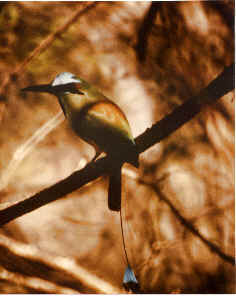
The Mayans called it "TOH".
We know it as the
TURQUOISE-BROWED MOTMOT.
We saw many during our June '08 Mexico Tour.
Links:
List of Birds & Other Wildlife during our Mexico Tour - June 2008
List of Birds of the Yucatan Region of Mexico (with photos)
Upcoming FONT Birding & Nature Tours in Mexico & Central America
The following narrative was written by Armas Hill, leader of the tour:
As noted in the
above title, the FONT June 17-26, 2008
Mexico Tour was mostly on the Yucatan
Peninsula, with a visit also to nearby Cozumel Island,
12 miles offshore.
The wording is "mostly on the Yucatan Peninsula" in that we also went
a few miles further south, into some wonderful, recently-opened, remote areas
that are still quite wild - close to the Mexican borders
with Guatemala and Belize.
Most notable of those southerly areas was Calakmul.
Not only is it remote, it's a not-often visited site of Mayan ruins, comparable
with those at Tikal
in Guatemala.
And, more than just Mayan ruins, Calakmul is also a vast reserve known as a biosphere.
When standing atop the
highest temple there, one sees to the horizon in all directions only a sea
of green foliage of forest.
Calakmul was one of 4 biospheres that we visited
during our tour, during which we found over 200 species of birds.
And there could have been more species yet as the Yucatan is a bird-rich area.
Of course, birds present in the month of June were mostly the residents.
Migrants from the north were mostly missing (with a couple exceptions).
There were a few migrants from the south (3) that come from South America to the
Yucatan to breed: 2 species of flycatchers and a vireo (to be noted further
along in this narrative).
But even without the many migrants that winter in the Yucatan, we still found,
in June '08, many birds - as noted, 200-plus species.
And a number of them were interesting, in that they were endemics and
specialties.
The Yucatan has a number of interesting species and subspecies as the
isolated region has evolved, due to a number of factors, to have its own
distinctive flora and fauna.
Thus, it has 14 endemic species of birds, and
almost 100 endemic subspecies.
The bird-life of nearby Cozumel Island is
also interesting. 3 endemic species and about 15 endemic subspecies occur
there.
Among our favorite birds of the June 2008 Mexico Tour were:
the endemic Yucatan Wren (the
last of the Yucatan species to be described, in 1934),
and the
nearly-endemic Mexican Sheartail.
That hummingbird has a very
interesting range. Like the Yucatan, or Black-throated, Bobwhite,
it is restricted to the Yucatan all but for a small isolated population
elsewhere. But on the Yucatan, it only occurs in the north, near the coast,
where its range has only the width of just over a kilometer!
However, even with all of the endemic & nearly-endemics notwithstanding, the bird that
we liked the most during our tour was one with an extensive range in Central
& South America.
But we saw it so well!
And it stayed - just a few feet from
us.
It was the little and brightly-colored American Pygmy Kingfisher, by
a small marsh in the forest in that wild area of Calakmul.

American Pygmy Kingfisher
Shifting from a
little bird, to looking at the bird picture, in part, a reason for our finding
so many birds during our Jun '08 Mexico Tour was because there are many birds, to be found,
in that area where we were.
Overall, about
540 species of birds, belonging to about 75
families, have been found in the Yucatan
region of Mexico, within the 3 states of
Campeche, Quintana Roo, and Yucatan.
Of these, nearly 60 are considered vagrants and occasional visitors. And so, simply
put, there are about 480 bird species that regularly occur in Mexico's Yucatan.
The total of about 540 is approximately half of all the bird species that
have been found in Mexico, (over 1,000), and nearly 60% of the number of bird species that
have been noted in the United States and Canada.
The diverse bird fauna of the Yucatan
is measurably enriched by the peninsula serving as a major thoroughfare for migratory
birds as they head south in the fall and north in the spring. Many of
those birds spread themselves out during the winter from southern Mexico to
South America.
In all, nearly 220 bird species from
the north have been noted in the Yucatan.
About 35 of them have been vagrants or only occasional visitors.
But nearly 130 of them over-winter in the Yucatan on a regular basis every year.
(A
few of these birds, such as the Blue-gray Gnatcatcher, also have a
year-round population that is resident in the Yucatan.)
Another group of northern migrants, numbering about 55
species, are predominantly transients, traveling through the Yucatan
Peninsula, as they rest and refuel before continuing on their journey.
Again, here, there are a few exceptions, as small populations of some of these
spend the winter, while 2 species maintain small Yucatan breeding populations
during the summer.
The high number of vagrants to the region is largely due to the combination of
tropical storms and weather systems known as "northers" that occur
during the peak of the fall migration in September and October. Those weather
conditions can blow some birds off their normal course.
There are also some unique, but regular, summer avian
visitors to the Yucatan region from
the Caribbean area, including Sooty and
Bridled Terns, Brown Noddy, and White-crowned Pigeon. They nest on
offshore islands and atolls.
Other summer visitors to the Yucatan include
the two flycatchers and the vireo that were noted at the beginning
of this narrative.
The Flycatchers are the Piratic and the Sulphur-bellied.
The Vireo is the Yellow-green.
These species fly north from South America to nest during the northern hemisphere's spring and summer
months.
As also noted, the Yucatan
region has a nice number of endemic bird
species (14, to be listed in the text that follows) and
endemic subspecies (almost 100!).
This endemism is due to the area's relatively late emergence from the sea
and then isolation from the interior of the country.
Nearly endemic to the Yucatan are two bird species that are, for the most part,
confined to the Yucatan Peninsula, but with
small disjunct populations elsewhere.
These two birds are the Yucatan Bobwhite and a most interesting hummingbird
known as the Mexican Sheartail. (There will be more about these 2 species
follows here in this narrative.)
When referring to the distribution of the Yucatan region's unique fauna, it is
sometimes necessary to include part of the Peten region in northern Guatemala,
and parts of nearby Belize, as some characteristic Yucatan wildlife occurs there.
Just a dozen miles offshore from the northeast coast of the Yucatan, is Cozumel
Island, which is very interesting for its own fauna & flora,
with even more endemism.
The 3 endemic species of birds found only on
that small island are:
the Cozumel Emerald (formerly part of the Fork-tailed Emerald,
with the male having the longest forked tail of the 5 former subspecies, now
species, that occur throughout Central America),
the Cozumel Vireo (with its cinnamon cheeks and sides),
and the rarely-seen, and critically endangered Cozumel Thrasher.
Cozumel Island is also home to a Caribbean
bird species that occurs nowhere else in Mexico, the Western Spindalis, which occurs nowhere
else in Mexico. The uncommon subspecies of that bird on Cozumel is endemic to
the island.
As elsewhere on a number of Caribbean islands, the Smooth-billed Ani has occurred
for a long time on Cozumel. From there, however, it has recently spread to the Yucatan mainland, where it is now along the coast, south of Puerto Morelos.
(We
saw the species, during our June '08 FONT tour, just south of Tulum.)
Elsewhere in Mexico, Anis are the Groove-billed.
A number of interesting endemic subspecies of birds occur on Cozumel,
including:
a distinctive form of the large Great Curassow,
and a small
version of the Roadside Hawk.
The curassow is critically endangered; the hawk is threatened.
Other interesting endemic subspecies on Cozumel Island include:
the "Cozumel Wren" (a notably different form of the House
Wren),
the "Golden Warbler" (conspecific with the Yellow
Warbler, but with the male sporting a rufous cap),
and unique races of the Rufous-browed Peppershrike, and the Blue-gray
Gnatcatcher.
The last of these subspecies, the gnatcatcher, duskier that others of its ilk,
was described in 1926 by Ludlow Griscom, a well-known birder/ornithologist from
Massachusetts.
The rare local Cozumel race of the Great Curassow (referred to a moment
ago) is also named after Mr. Griscom, "Crax r.
griscomi". It, by the way, is the only subspecies of that curassow,
other than the nominate in Central America.
Even more endemic subspecies are on little Cozumel Island, including those
of these:
Rose-throated Tanager (uncommon),
Golden-fronted and Yucatan Woodpeckers,
Bright-rumped Attila,
Yucatan Flycatcher,
Northern Cardinal,
and the Black Catbird.
That of the Black Catbird was only recently described as such, just a few
years ago.
The Cozumel subspecies of the Yellow-faced
Grassquit and the Bananaquit are only on that island and on the
nearby, smaller Holbox Island.
That subspecies of the Bananaquit has also, in recent years, been found
along the Quintana Roo coast (that is,
the eastern coast of the Yucatan Peninsula), as well as on northern offshore cayes
(or islands) in Belize, where it was unknown
prior to the 1980s.
In all, the total number of bird species known to have occurred on Cozumel
Island is well over 200.
A complete listing is elsewhere in this web-site: COZUMEL
BIRDS
In addition to the 3 endemic bird species just noted as being on Cozumel
Island (the Emerald, Vireo, & Thrasher),
the other 11 endemic birds of the Yucatan
region are:
Ocellated Turkey
Yucatan Amazon (or Parrot)
Yucatan Poorwill
Yucatan Nightjar
Yucatan (or Red-vented) Woodpecker
Yucatan Flycatcher (in the Myiarchus genus)
Yucatan Jay (with its bright, yellow legs)
Yucatan Wren (described as a species only as recently as 1934)
Black Catbird
Rose-throated Tanager
Orange Oriole.
To this list, the Ridgway's Rough-winged Swallow could be added, as it is
a "quasi-endemic" of the Yucatan region, being a resident that breeds
in that area, as well as in nearby Belize, northern Guatemala, and slightly
further west in Mexico.
Mention has been made here, a couple paragraphs ago, to the Yucatan (or
Black-throated) Bobwhite and to a hummingbird,
endemic to Mexico, called the Mexican Sheartail.
Its name not withstanding, the Bobwhite is not truly endemic to the
Yucatan, as a few disjunct populations have been found, including one in
Honduras.
The Mexican Sheartail is another such species, with another separated,
and in fact very isolated, population. In addition to being along the north
coast of the Yucatan peninsula, close to the sea, it is also known to be in just
a very small area, hundreds of kilometers to the west, in central Veracruz.
The northern Yucatan population of the Mexican Sheartail is found
exclusively in a very narrow range that's only about 1 kilometer wide - mainly
between mangroves and tropical deciduous forest. It has also been found to breed
in gardens. That population of the species is considered "threatened".
The smaller Veracruz population of the Mexican Sheartail is in
undisturbed, dry deciduous forest and overgrazed habitats at about 25 kilometers
inland. That population is critically endangered.
In the northern Yucatan, the Mexican Sheartail has been observed feeding
at flowers of Ipomoea, Justicia, and Helicteres guazumaefolia, and its diet is
supplemented by small anthropods. The bird is often close to the ground.
Just offshore from the narrow range of the Mexican Sheartail in the northern
Yucatan, there are flamingos, as many as thousands of them.
They nest in the late spring and summer in and near the Rio
Lagartos Special Biosphere Reserve. Many of them spend the winter a
couple hundred or so kilometers to the west, as the flamingo would fly, at the Rio
Celestun Special Bioshpere Reserve.
These birds have long attracted notice. Flamingos, in all likelihood this
population, were recorded as being prominent members of the Aztec Emperor
Montezuma's menagerie.
Although there are still thousands of them, conservationists take a special
interest in the flamingos because their specialized habits make them
vulnerable to drastic population declines. Their numbers have fluctuated in
recent years.
The method by which they feed, that is dredging the bottom sediment of shallow
lagoons and estuaries, makes the birds susceptible to toxics in the mud, such as
the lead from leadshot used in shotguns.
The flamingos feed only in areas with very specific water conditions,
which can change abruptly. That happened in 1988 when Hurricane Gilbert damaged
some of the flamingos' prime feeding areas, causing them to seek other
sites. Many died. Also, their nests on mudflats, are easy targets for egg and
chick predators, such as raccoons and foxes.
Yet, the Mexican flamingo population is considered fairly healthy, having
risen from a low of between 8,000 and 12,000 individuals in the 1970s (when
the Rio Lagartos & Rio Celestun Reserves were created), to about 26,000
birds in the mid-1980s. Hurricane Gilbert (as noted, in 1988) was a
setback to this population growth, but the flamingos have since recovered.
During the FONT tour in June 2008, we saw a number of flamingos. With
adults, there were young birds.
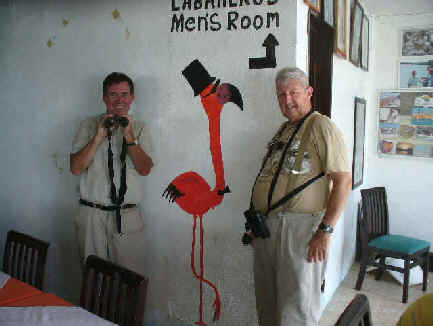
Armas Hill (left) &
Fred Lesser (right)
during the June 2008 FONT tour in the Yucatan of Mexico
before seeing the flamingos - the real flamingos.
Fred has participated on many FONT tours over the years.
At the edge of one flock of
flamingos, a "Great White Heron" was
walking in the shallow water. That bird is actually a white morph of the Great
Blue Heron, Ardea herodias occidentalis.
In that area of estuaries, mangroves, mudflats, and sandbars, we saw many
waterbirds. Long-legged waders, in addition to American Flamingos and Great
Blue Herons (both dark birds & the single one), included:
Roseate Spoonbill, White Ibis, Little Blue and Tricolored
Herons, Reddish Egrets (white birds), other white Egrets: the Snowy
and the Great; also Green Heron, Yellow-crowned Night heron,
Boat-billed Heron, Bare-throated Tiger Heron, Magnificent Frigatebirds, Brown
Pelicans, a flock (even in June) of American White Pelicans,
Neotropic Cormorants, Anhinga, Laughing Gulls, and 4 species of Terns:
Gull-billed, Sandwich, Royal, and Least. Also (even In June), we
saw 10 species of shorebirds, including the Snowy Plover.
We learned that just a couple weeks prior to our being there, the Jabirus,
that nested in the area, departed. They had raised 2 young, during their 4th
year of year of nesting there. Yes, birds beget birds. Many bird species in that
region are common. Jabirus, there, and anywhere in Mexico, are rare.
On sandbars where we saw terns, we learned that at another time of the
year, there are gulls. And, among them, we were told, both Lesser
Black-backed Gulls and Kelp Gulls have been seen together during
recent years. That's interesting, of course, as Kelp Gulls are
normally in the Southern Hemisphere, and the Lesser Black-backed Gull
has, over time, been primarily a European breeding bird, wintering south to
Africa.
It's also notable that the affinity that the coastal vegetation of the Yucatan
Peninsula has with the Caribbean region
provides habitat for a number of birds found nowhere else in Mexico, These
include: Zenaida Dove, White-crowned Pigeon, Caribbean Elaenia, Yucatan Vireo,
and Western Spindalis.
To that list, now, a bird that has recently arrived, can be added, the Shiny
Cowbird.
Another bird of the Yucatan with an unusual distribution is the White-lored Gnatcatcher,
found only along the north coast in the state of Yucatan. Otherwise, it inhabits
parts of the west coast of Mexico, with most of its range further south in
Central America.
Generally, most of these birds occur in areas of the Yucatan
region that are protected. There are approximately 40
natural protected areas in the region, covering
almost 9 million acres. These places include both terrestrial and
marine habitats, and include both public and private reserves.
Additionally, 24 sites on the Yucatan Peninsula have been designated as "Important
Bird Areas" (IBAs).
Also worth a mention, of course, are the 5 Biosphere
Reserves in the Yucatan that have been established by the UN
Educational, Scientific, & Cultural organization for both the protection of
the natural areas and the conservation of land for local people.
All but 17 of the bird species that are included in the "Yucatan list"
are to be found within natural protected areas in the region. And that's a
lot of birds!
Here, in order, are
the "Top Birds" of our June 2008
Yucatan, Mexico Tour, as voted by the participants:
1 - American Pygmy Kingfisher
(the number #1 bird, as it was so
cooperative, when it sat still, tamely, so close to us)
2 - Yucatan Jay
(with wonderful, bright yellow legs!)
3 - Slaty-breasted Tinamou
(seen walking across the road, in front
of us)
4 - Black Catbird
(a nice regional specialty, as it was
common & easy to see)
5 - Great Curassow
(also seen walking across the road in
front of us - the same road as was the tinamou)
6 - Turquoise-browed Motmot
(a bird filled with color - once we saw
a bare tree filled with these birds, with about a dozen on the branches)
7 - Cozumel Vireo
(a nifty endemic to the island, with
cinnamon cheeks & sides)
8 - Orange Oriole
(one of a number of bright,
orange-colorful orioles - we saw many such colorful birds)
9 - Yucatan Nightjar (and other "goatsuckers")
(along one dirt road, one night, 3 of
these species were seen; the endemic Yucatan Nightjar was so very well)
10 - Least Grebe
(like small toys close to our feet, as
they were on the water at the edge of a pond - so tame those birds were)
![]()
FONT E-News,
Volume 9, No. 2
February 12, 2008
from Focus On Nature Tours, Inc.
"The FONT Birding & Nature Tour in the Lesser Antilles in Dec '07/Jan '08"
The following account was written by Armas Hill, leader of the tour:
This was the FONT
Annual Holiday Tour for Dec/Jan 2007/2008, to the Caribbean
islands of Saint Lucia, Saint Vincent, and
Dominica. During the last days of 2007, we were in
Saint Lucia & Saint Vincent.
Our birding during the first days of 2008 was in Dominica.
Each of the three Lesser Antillean islands just mentioned has, in relation to
birds, something in common. And that is that Parrots, in particular Amazons,
endemic to those islands, continue to live there.
At the time of Columbus's voyages in the Caribbean, there were, on various
islands, 11 species of Amazon parrots, and even on some islands, macaws,
larger than parrots. No macaws exist any longer on any Caribbean
island. They were on various islands in both the Lesser and the Greater
Antilles. The last of the Caribbean macaws disappeared in Cuba in the mid-1800s.
Of the 11 species of Amazons that existed in Columbus's time, 2 are now extinct (one
each on the two French islands of Guadeloupe and Martinique), and 1 is
severely endangered (on Puerto Rico).
Overall, however, (aside from the Puerto Rican Amazon),
the species that have been in the most peril have been those in the Lesser
Antilles.
The rare Imperial Parrot, Amazona imperialis, of Dominica
(known there as "the Sisserou") has a plumage that resembled
the Amazon now extinct on the nearby island of Guadeloupe. It's the largest of
all the Amazon parrots. In the Western Hemisphere, there are 31 species of
Amazons in the Caribbean and in Central & South America. The Imperial Parrot
was one of the last Amazons described to science, and one of the last birds to
be described in the Nineteenth Century, in 1899.
Dominica's Imperial Parrot is rare. Not ever common, it was
declining until the 1990s. At the beginning of that decade, the total population
was said to be 50 birds. Through the 1990s, there was an increase, until today,
when it's said that are about 250 individuals.
The other Amazon that's endemic to Dominica is the Red-necked Parrot, Amazona
arausiaca. That attractive parrot is also called the "Bouquet's
Amazon". In Dominica, it's known, by the local people, as either the "Jaco"
or the "Perroquet". It was described to science as early as
1776. Today, the population of Red-necked Parrots is said to be between
500 and 1,000 birds.
During our Dec 07/Jan 08 tour in the Lesser Antilles we saw both the Imperial
and the Red-necked Parrots when we were in Dominica (in January), and
both the Saint Lucia and the Saint Vincent Parrots when we were on
those islands (in December).
The Saint Lucia Parrot, Amazona versicolor, is known to the
people on that island as the "Jacquot". It is the national bird
of that island country. The children are taught about it in school, and nearly
all of the people with whom we spoke on the island knew of the bird. The
educational program in the schools was initially carried out by a friend of ours
that we used to meet during our St. Lucia tours in the 1990s, when he lived in
that country. He no longer does, but we have good memories of Paul Butler, who,
for years, was affiliated with the conservation organization known as RARE.
Even though we weren't able to see Paul, during this our 15th FONT tour on Saint
Lucia, we saw, once again, as we always have, the Saint Lucia
Parrot flying about late in the day in the forested hills.
The total population of the Saint Lucia Parrot is now said to be between
350 and 500 birds. It can safely be said that conservation efforts, as those
just alluded to, have saved this species from extinction.
Maybe the Amazon that we enjoyed the most during our 07/08 Holiday Tour
was the Saint Vincent Parrot, Amazona guildingii.
Another name for it has been the "Guilding's Amazon".
Whatever it's called, it's a brilliantly colorful bird with some white, yellow,
blue, and bright orange-yellow in its plumage. Its habitat is moist forest in
the hills.
During most of the 20th Century, the population of the bird declined. In the
1980's, it was as low as about 400 birds. Since then, with conservation efforts,
the population has increased to now maybe about 800 individuals.
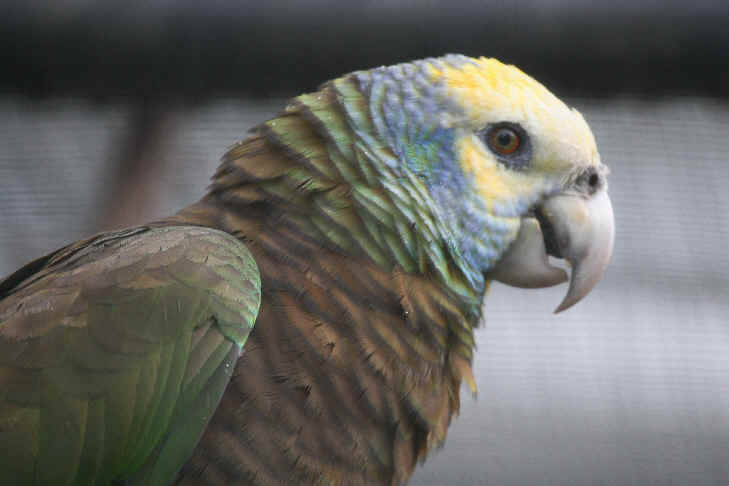
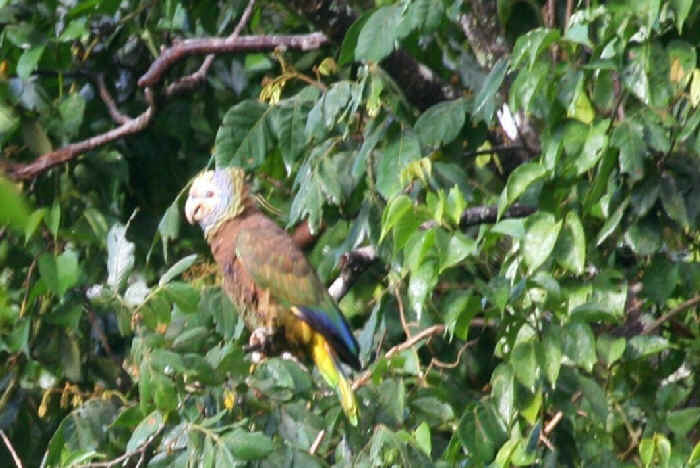
The colorful
Saint Vincent Amazon,
photographed during the FONT tour in December 2007.
Above: a captive bird in the botanical garden.
Below: in the wild, in the forest.
(photos by tour participant, Marie Z. Gardner)
While in Saint
Vincent, we visited a places called Vermont
and Montreal. No, Vermont wasn't a
place with maple syrup and ski slopes. And no, Montreal was not a large city.
Vermont (or "Green Mountain") was
where we saw the parrots, and some other birds too, in what was a moist
forest when we were there. But, yes, we did enjoy seeing those parrots
flying about in the wild, and even perched closely in a nearby tree, after the
rain stopped and as the late-afternoon sun brilliantly shone on the birds.
Montreal was not really too far from
Vermont. It was actually on the "other side" of the hills from the
parrot. I say "Montreal", but it was actually Montreal Gardens, a nice
place with some nice birds including the Lesser Antillean Tanager (a
species restricted to only the two Lesser Antillean islands of Saint Vincent
& Grenada), and rare Whistling Warbler (endemic to Saint
Vincent), and the Brown Trembler (an aberrant thrasher
with yellow eyes and a long bill that appears to "tremble" as
it continually shakes its wings).
Some other places where we were on St. Vincent are worth a mention. Our
overnights were in the largest town on the island (but not really large)
- Kingstown. The neat old cobblestone building near the port was, years ago, a
sugar warehouse. In the 1970s it was made into a nice hotel. We were there on
New Year's Eve, and even though we were in town, it was about as quiet a place
for New Year's Eve as there could be.
Nearby, earlier on New Year's Eve, we had an evening bite to eat at an outside
courtyard of another hotel, the Heron Hotel. As we ate, a Green Heron
walked by, next to us, in what was not much more than a little drainage ditch.
Across the street, a Little Blue Heron flew into a tree. Evidently, that
hotel, in the middle of Kingstown, was aptly named.
A day or so earlier, there was still an air of Christmas, as we went about.
Again in Kingstown, outside an old church, in the churchyard, as we observed a
few species of birds, the congregation, inside the church, beautifully sang a
Christmas hymn. It was a nice touch during our annual "Holiday Tour".
At the already-mentioned Montreal Gardens, and growing wild elsewhere as well,
there were bright red Poinsettia plants, adding even more to the season, even
though we were far away from winter, on a tropical island.
On the other tropical island where we stayed, St. Lucia,
there were some notable settings and sights. Of course, the two tall Pitons (or
peaks) were overwhelmingly scenic. And the Saint Lucia Oriole (an
endemic) was also a nice sight.
For some, maybe the best setting of the tour, was atop a particular high cliff
by a lighthouse. In hefty winds at that place, there were as many as 50
Red-billed Tropicbirds in fast flight, both above us and below us by the
cliff. Noisy they were, calling as they flew. Being with those extraordinary
birds, that are often far out at sea, was certainly one of tour's highlights.
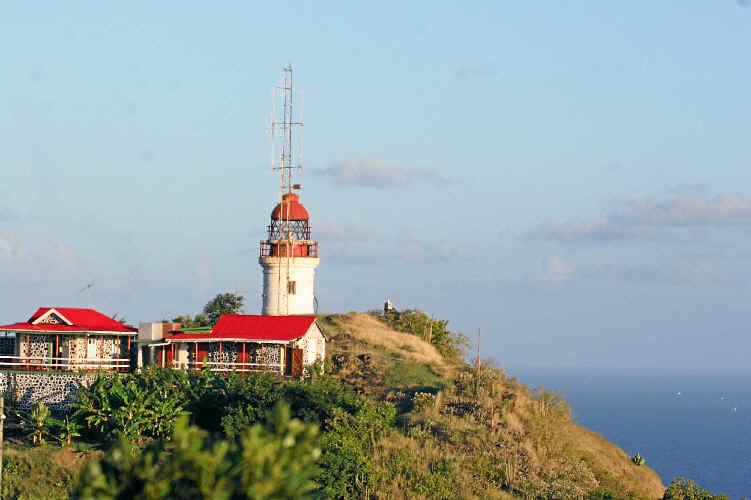
Above: A lighthouse atop a
cliff in Saint Lucia.
Below: One of a few dozen Red-billed Tropicbirds below the cliff.
(photos by Marie Gardner during the Dec 2007 FONT tour)
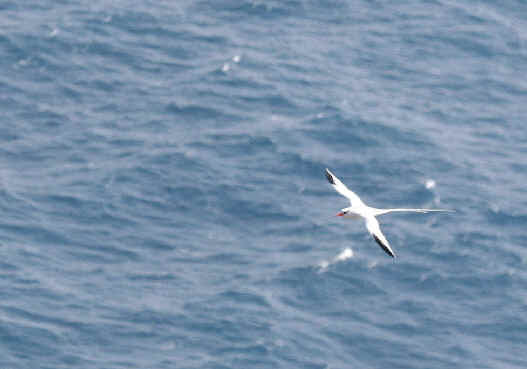
At another point during our tour, as we were in the van on St.
Vincent, the subject somehow came up of the movies "The
Pirates of the Caribbean". Apparently, there were 3 such movies,
and they were filmed on St. Vincent and Dominica
(two of the islands included in the itinerary of our tour). Anyway,
our driver then told us that we were in the same van, and the same seats, used
by the cast of the movie. One of us was where Johnny Depp sat. Another was in
the sea where Keira Knightley was, and another in the one used by Orlando Bloom.
Of course, a name for our tour was close to that of the movie. We came to see "The
Parrots of the Caribbean", and that we did.
And it was wonderful doing so, as it was seeing others of the avian cast - the hummingbirds,
the thrashers & tremblers, the solitaire (with its
beautiful song), the Warblers (Whistling, Plumbeous,
& St. Lucia) the frigatebirds & boobies (that
were flying about by the "Pirates of the Caribbean" movie set that we
visited ), and the bananaquits and bullfinches that would fly
into our rooms when we'd leave the doors open.
In all, we had a enjoyable tour, during which we saw some birds that are rare,
and others with a restricted range that's just a small dot on the global map.
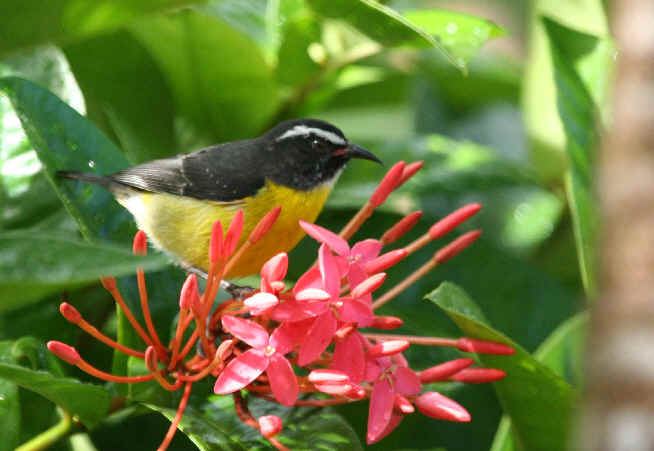
Throughout
much of the New World,
and particularly in the Caribbean,
there are a number of subspecies of Bananaquits.
That number is 41.
The Bananaquit on the island of Saint Lucia (above)
is quite different than that (below)
on the nearby island of St Vincent.
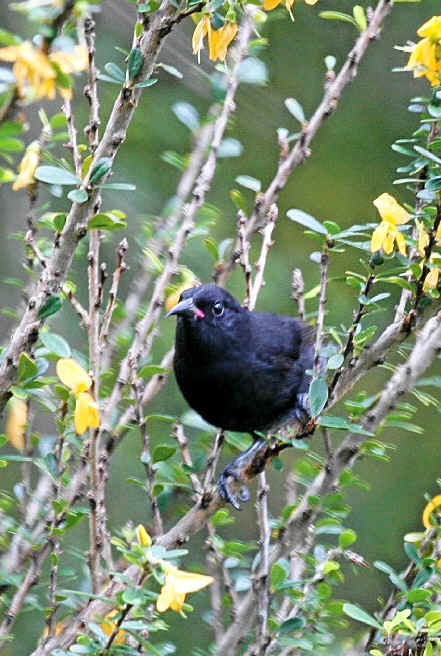
![]()
FONT E-News,
Volume 8, No. 11
December 23, 2007
from Focus On Nature Tours, Inc.
"The
FONT Birding & Nature Tour in Japan, in December 2007,
with Cranes, Eagles, the Blakiston's Fish-Owl, & more
The following account was written by Armas Hill, leader of the tour:
It all began for me at the airport in Philadelphia in the US. I was there,
early, awaiting my flight to Chicago to connect to a non-stop flight to Japan
that could go west over Canada, Alaska, and the Pacific.
At the last moment, the word came that there was a mechanical problem with the
plane and that flight was cancelled. Those who were to connect to go to the
Orient were directed to taxis to JFK Airport in New York, but without enough
time to get there. No one, scheduled for the cancelled flight, would get to
Japan less than a day late. Except me.
Rather than join the ill-fated venture to New York, I convinced the airline
personnel to allow me to take a flight a few hours later in the opposite
direction to Europe - to Frankfurt, Germany - and then continue on another
flight, across mostly Russia, to Japan. Doing so, I arrived to meet our tour
members, in Kyushu, Japan, just under 2 hours later than originally scheduled.
Those people, who became "our group" went to Kyushu from places such
as California, Okinawa, and Thailand.
There have been FONT tour participants in Japan, over the years, from a number
of countries throughout the world including: England, Scotland, the island
of Jersey, France, Germany, the Netherlands, Austria, Hungary, South Africa, and
Australia, in addition to Canada and the United States. Thailand, this time, was
yet another country to be added to that list.
This tour, conducted December 10-18, 2007,
was the 29th FONT birding & nature tour in Japan.
18 of those tours have been in the late-fall and winter. 11 have been in the
spring.
As I was flying east, for hours across Russia, I couldn't help but think of how
vast that land is - huge, actually, Eurasia, continuing further east, over
Siberia. In days gone by, it took a very long time for the early explorers and
scientists to get from places in Europe such as Germany, England, France, and
western Russia, to the frontier of eastern Eurasia and beyond. In the 1700s, for
people such as Steller, Pallas, and Bering, it was a lengthy trip indeed. What I
did in hours, took them months.
I looked out the window of the plane and down upon eastern Siberia and then the
rugged, cliffy coast of the Pacific north of Korea and Manchuria. I was looking
down on a part of the world that's still a wilderness, with Siberian Tigers,
rare Scaly-sided Mergansers, and the mainland Asian populations of Blakiston
Fish-Owls and Red-crowned Cranes. And many other birds, too, occur in
that region that we (our group from places as far away as the US and
Thailand) were to see in Japan.
Such birds, in that category, avian travelers from Siberia to Japan, were to
include: Steller's Sea Eagles (named after the George Steller just
referred to), White-tailed Eagles, Whooper Swans, various ducks,
Rough-legged Hawks, White-naped Cranes, and Hooded Cranes, among the
larger birds, and others, smaller, such as the Daurian Redstart,
Yellow-throated Bunting, Northern Lapwing, and Rook, that only winter
in Japan.
The mainland Asian populations of the Blakiston's Fish Owl and the Red-crowned
Crane, noted a moment ago, never mix with those now isolated on the northern
Japanese island of Hokkaido. During our Dec '07 Japan tour, we saw both of those
species.
The Red-crowned Crane is always great to see - tall and stately. There
are now about 1,000 of them that are residents in Hokkaido - the only place
where the species normally occurs in Japan. Even just 30 years ago, there were
considerably less. That species was determined by votes, at the end of our tour,
to be our favorite bird (the list of "top birds" is below).
The massive Blakiston's Fish Owl in Hokkaido
(also only there in Japan) is not only very big; it's very rare. We saw
it - again. I say "again" as we've seen that spectacular species
during ALL of our 18 late-fall and winter tours in Japan. The rivers in Hokkaido
where the owl occurs were not yet frozen when we were there, this time, in
December. So, we were fortunate to have the good look at the big owl that we
did, one day at dusk.
A number of the birds already mentioned are among the "top
birds" of this tour, as voted by the participants at the end of it. Here's
the list of those "top birds":
#1 - RED-CROWNED CRANE
2 - Steller's Sea Eagle
3 - White-naped Crane
4 - Mandarin Duck
5 - Blakiston's Fish-Owl
6 - Smew
7 - Black-faced (& Eurasian) Spoonbills
8 - Green Pheasant
9 - Harlequin Duck
10 - Mountain Hawk-Eagle
11 - Laysan Albatross
12 - Hooded Crane
13 - wagtails (3 species)
14 - Black Kite
15 - Common Kingfisher
16 - Great Spotted Woodpecker
17 - Daurian Redstart
18 - Meadow Bunting
19 - Rook
20 - Eurasian Wigeon
21 - Pygmy Woodpecker
All of the birds receiving Number #1 votes (except one) were cranes,
with the Red-crowned Crane receiving 3 and the White-naped and Hooded
Cranes receiving one each. The single exception was the Steller's Sea
Eagle that sat so cooperatively, not far from us, atop a pole. Many times,
such eagles don't allow close approach, but the one just referred to was
so reluctant to leave its favored perch, as we stood nearby photographing the
bird, talking among ourselves, and even moving about. We had to conclude that
where that bird came from in Siberia there simply were not many people.
Another raptor that was seen perched in a big tree in Hokkaido was
unexpected. It was the Mountain Hawk-Eagle. The subspecies that's
resident in Japan, Spizaetus nipalensis orientalis, is larger than
others that occur in mainland Asia, in southern China and west into the
Himalayas. The bird that we spotted as we were traveling through hills in
southern Hokkaido was big. It was unexpected because we've never seen it
previously in Hokkaido. It has relatively recently been found to nest there. We
have seen the species during previous FONT Japan tours in the mountains and
hills of Honshu and Kyushu. Southern Hokkaido is the easternmost edge of the
bird's extensive range.
Another raptor that was good for us to see on Hokkaido was the Roughleg.
Now, that name is a compromise. In Eurasia, it's been called the Rough-legged
Buzzard. In North America, it's been known as the Rough-legged Hawk.
With whatever name, we saw a couple of them along the coast, hovering in the
air. One was doing so right above us. It was a nice sight with the backdrop of a
blue sky. Roughlegs in Hokkaido come from either the Kamchatka Peninsula
or further north in Siberia, from the tundra.
Among other birds that come to Japan from Siberia to spend the winter, Whooper
Swans are particularly notable (and hard to miss). On Hokkaido, we
saw them at a number of lakes and inlets. But they are always fun to see, and to
hear. They can be noisy. Hence their name. In that regard, someone during our
tour asked "Why is one a Whooping Crane, and another the "Whooper
Swan?" That's a good question.
Some of the other species of waterfowl during our tour were wonderful birds.
Among them, the Smews that we saw were very nice. The male, with its
distinctive white and black plumage, is truly striking. The red-headed female is
dapper. All in our group were glad to see the Smews as well as we did. One
person was particularly so, as she said that she's seen the word for years in
crossword puzzles. Now, at last, she saw the bird.
Smews come to Japan in the winter from Siberia. They don't nest in Japan.
But Harlequin Ducks do. They occur commonly along the Hokkaido coast. No
matter how common, they're always a treat to see. The male is downright gaudy.
The Falcated Duck is another attractive duck that we saw in Hokkaido. Long-tailed
Ducks, there, along the coastline are also dazzlers.
Scoters, that breed further north in Siberia, were in numbers for us
along the Hokkaido coast. We saw two kinds. The "Black Scoter"
in Japan is actually the American Scoter, now split from the Black
Scoter that occurs further west in Eurasia. The "Steininger's"
White-winged Scoter that we saw is a subspecies of the White-winged
Scoter of North America, rather than the Velvet Scoter of
more-westerly Eurasia.
But maybe no species of waterfowl more exemplifies the Orient than the Mandarin
Duck. It's similar to the Wood Duck of North America, but with a
different coloration. A few years ago, we found during a FONT tour in southern
Kyushu (the southernmost main Japanese island), a river that in the
winter (only) is filled with them. Shy, these wild Mandarins are.
They fly away quickly, calling as they go. These birds, that winter in southern
Kyushu, breed either further north in Japan, or across the sea in mainland Asia,
in places such as Korea and Manchuria. Again for us, in December '07, we saw
hundreds of them. It was quite an experience.
Every winter, thousands of cranes come to southwestern Kyushu from
mainland Asia. Mostly, they are of 2 species: the Hooded Crane and the White-naped
Crane. Not to slight the Hooded, but a comment must be made that the White-naped
Crane is really a most attractive bird.
Both of these cranes are, during the summer, spread out in the land that was
below me when I was in the plane, on my way to Japan from Germany, over eastern
Asia. They nest in Russia and Manchuria (and elsewhere in northern China).
Like me, they fly to Japan. These cranes come to Kyushu, in southern
Japan, by the thousands, arriving mostly in November and departing in February.
In mainland Asia, as noted, they range across a rather large area, but in Japan,
when they visit for the winter, they're restricted to just a few square
kilometers.
We learned, during our December '07 tour, that a couple weeks earlier, the first
count for the season of the cranes in that part of Kyushu was: 10,973
Hooded Cranes, 1,059 White-naped Cranes, 2 Sandhill Cranes, 3 Common Cranes,
and 3 hybrids (between Hooded & Common Cranes).
It's quite a sight to see those cranes at Kyushu. The Hooded Cranes there
are nearly the entire global population of the species. As to the White-naped
Crane, a recent total population estimate was about 5,000 birds. Lately,
about half have been wintering where we were in Kyushu.
We also saw, during our Dec '07 tour, one of the 2 Sandhill Cranes in the
area. The Sandhill Crane is mostly North American, but actually it's also
a breeder in northeastern Siberia. Most of those birds, after nesting, migrate
east to Alaska and then south into North Carolina. But not all. As noted, 2
arrived in Japan in '07 to winter. The species has been an annual there in
recent years.
Another bird that we saw on the southern Japanese island of Kyushu that came
from mainland Asia for the winter was the rare Black-faced Spoonbill. The
global population of that bird of eastern Asia only totals about 700 birds. It
does not breed in Japan. The species nests mostly in Korea, with a few doing so
in coastal China. We saw, in December '07, seven of these birds along with
almost as many Eurasian Spoonbills on a mudflat by the mouth of the river
where, upstream, we saw the hundreds of Mandarin Ducks. The Eurasian
Spoonbill is a winter visitor (a non-breeder) in Japan, occurring in
small numbers.
In an area of Tokyo, near the head of the Tokyo
Bay, we stopped by one afternoon to see the shorebirds. They
were there. Most were Dunlin. Also, in addition to 3 species of
plovers, there were a couple Eurasian Curlews and a small grouping of
Black-winged Stilts. Also stopping by that afternoon to visit the
shorebirds was a Peregrine Falcon that rapidly stooped in causing the
shorebirds to quickly take into the air, flying fast in one direction and then
the other in tight formation. Watching a flock fly like that is always amazing.
A part of our December 2007 Japan tour was offshore, onboard a large ferry from central
Honshu (the main Japanese island) north to Hokkaido.
The ferry-ride was overnight, and then all-day. It's good that the ferry is
large as, at times, the ocean was a bit rough. But during nearly all of the
daytime portion of the trip, there were birds in view. By far, the most were Black-legged
Kittiwakes. We saw thousands of them. It was easy to become very respectful
of that bird as we watched them continually about fly in the strong winds. Of
the two Kittiwakes in the world, the Black-legged is by far the
most common. The other, the Red-legged Kittiwake, is rather rare, and
generally a bird of the more-northerly Bering Sea. "The book" says
that the Red-legged Kittiwake can occur in the offshore waters of Japan.
Maybe so, but we never saw one (that we know of) among maybe 25,000
Black-legged Kittiwakes we saw that day at sea.
What we did see in nice numbers were Laysan Albatosses - at least 75 or
so. It was fun to watch them in their arcing flight. Other seabirds we
saw from the ferry, that December day (Dec 13, 2007) were: some Pomarine
Skuas, both Streaked and Short-tailed Shearwaters, and both Fork-tailed
and Sooty Storm-Petrels. With the storm-petrels, a Pterodroma
quickly appeared - a Bonin Petrel. Then it quickly disappeared.
Gulls (other than the kittiwakes) were in lesser
numbers than during our January trips, and alcids were considerably less,
although some Japanese Murrelets were seen - "umisuzumes",
in Japanese meaning "sea sparrows".
In an area of the ocean where there were many birds above the surface of the
water, and apparently many fish below, there were Northern Fur Seals at
the surface of the water busily catching the fish.
Mammals that were seen on land, during the tour, included: Sika Deer,
Japanese Marten, Japanese Hare, and Eurasian Wild Boar in Kyushu,
and Sika Deer and Red Fox in Hokkaido.
Not just were there birds and animals to be seen, enjoyed, and appreciated
during our December 2007 tour in Japan. There was also the beautiful Japanese
countryside, the culture, and cuisine, in addition to the Japanese
accommodations with the "onsens" (Japanese baths), and the
hospitality of our hosts at the various places where we were. And, of course,
there was our group of travelers from far-flung places such as Thailand and
California. Combined, all of these elements made our tour, simply put, a
wonderful experience.
At the end of it all, I boarded a plane in Japan to continue the journey
completely around-the-world by air, that was done in conjunction with this tour,
flying to Dallas, Texas, and then back to Philadelphia and home.
In notes following our DECEMBER 2007 birding
& nature tour in JAPAN:
"Thanks for a great
trip. I hope to see you on one of your tours soon."
Dorothy Kakimoto
Alameda, California
"Thank you for a wonderful trip."
Alice Kakimoto
Garden Grove, California
"Dear Armas,
You are so much fun to travel with --- .
You are a good driver (on the left-side of the road in Japan), and a great
bird-spotter.
Thank you for a safe, amazing trip in Kyushu & Hokkaido on roads less
traveled.
I loved every moment.
What a great trip. Thank you."
Mitsu Wasano
San Jose, California
"Thank you so much for the tour - for the adventure, and the birds".
Somporn Pmasuk & Opapunn Sriyakorn,
Bangkok, Thailand
"In my list (at the end of the tour) of "top-birds", I chose
those I did because I can now identify them by myself. Thanks for
everything!"
Somporn Pmasuk
Bangkok, Thailand
![]()
FONT E-News,
Volume 8, No. 4
June 28, 2007
from Focus On Nature Tours, Inc.
"FONT Birding & Nature Tours in Puerto Rico"
We
received an inquiry recently from the editors of "Islands" Magazine,
asking some questions regarding our birding & nature tours in Puerto Rico:
What makes the tour unique?
What's a favorite aspect of the tour?
What are some things that a person wanting to join the tour should know?
And, when on the tour, is it easy or difficult?
Here we thought, in an e-mail bulletin, it might be good to share our answers to
these questions with you.
Probably what does make our FONT tours in Puerto Rico
"unique" (and we've done 27 such tours since 1990) is that we
spend much of our time in what might be called "the other Puerto
Rico", that is away from the resorts and the cruise ship docks, and
away from the metropolitan sprawl of San Juan.
Puerto Rico, with its countryside, is a beautiful island. Most of our time, during our PR tours, is in the western part of the island, where we visit a variety of habitats.
In forests, in the limestone or "haystack" hills of western Puerto Rico, there are not only interesting birds to find, there's an enjoyment of being in such a nice place.
The southwest corner of the
island (a dry habitat), both by the coast and inland, is a wonderful
place to be. There are cliffs by the sea, areas of lagoons, as well as some
places with cacti and others with luxuriant foliage. In all of these varied
places, we look at birds and other aspects of nature, such as the butterflies,
plants, and some non-avian wildlife.
From caves, at dusk, we see flying bats. Offshore, from a boat at sea,
we've observed not only oceanic birds (such as terns & tropicbirds),
but also the largest fish in the world (the Whale Shark).
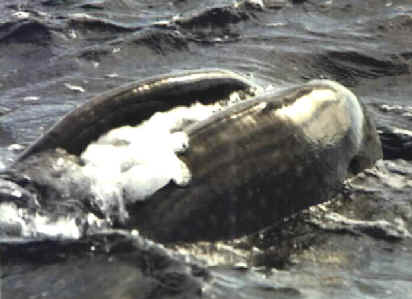
A Whale Shark photographed during an offshore boat-trip
as part of a FONT Puerto Rico Birding & Nature Tour.
(Photo
courtesy of tour participant Marie Z. Gardner.)
From shore, in northwest Puerto Rico, we've seen the even-larger whales
themselves, Humpbacks, breaching (that is, jumping) sometimes
completely out of the water.
Elsewhere along the Puerto Rican coast, the sluggish West Indian Manatees
spend nearly all of their time in the water.
But regarding the birds themselves, during our tours, we see about 100 species of them. Some of these are visitors during the winter from the places to the north (following pretty much the same calendar as many human tourists).
Other birds migrate through Puerto Rico, using it as a stepping-stone between North & South America.
And yet other birds are in Puerto Rico all-year long. A number of these are "endemics", that is species that occur no where else in the world. There are just over 15 bird species found only in Puerto Rico.
They include:
a very rare parrot (one of the rarest birds in the world),
a rare blackbird with yellow wings (called locally the "Mariquita"),
a marvelous little bird called the Tody, about 4 inches in length, with
an emerald-green back, a white breast, yellowish belly, and a bright red throat.
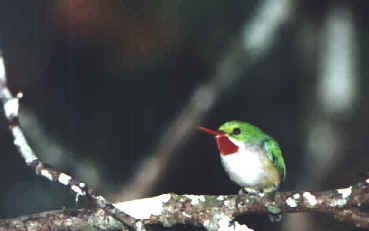
The Puerto Rican
Tody,
seen nicely during every FONT tour on that island.
Among the other endemic birds, there are: 2 types of tanagers, 2 kinds of
warblers, 2 hummingbirds, a woodpecker, a cuckoo,
and an owl that during the dark of night gives a full repertoire of
sounds, including trills, chatter, and even a maniacal laugh.
If one were to have had a book
about Puerto Rican birds when JFK became president, two of the endemic birds of
the island would have been missing.
One, a nightjar (like a Whip-poor-will) that hides
by day, and catches insects around dusk and dawn and in between, was thought to
be extinct for over 70 years. It was re-discovered in 1961, and to this day, it
lives in a very restricted range in dense shrubbery the Puerto Rican dry forest.
The other bird that would not have been in the book is a small black-and-white warbler
that was discovered for the first time as recently as 1971. Even on populous
Puerto Rico that bird remained unknown to science for years! It's called the "Elfin
Woods Warbler" because it lives in small trees on mountaintops.
When many people think of nature in Puerto Rico, they think first of the rainforest, because a place known as "El Yunque" (a rainforest in the mountains east of San Juan) is well known. It is really a wonderful place, now preserved as a US National Forest. But, as noted earlier, it's just one of an assortment of habitats on the island. And so, it is just one of the places visited during the Focus On Nature Tours in Puerto Rico.
Yet one more member of the Puerto Rican cast of natural characters should be mentioned - the widespread Coqui Frogs. At night, their loud calls are heard continually. As easy to hear as they are, these little creatures, that are usually in trees, are hard to see. As frogs in much of the world have declined in recent decades, it's wonderful that the Coqui calls are such a prevalent and characteristic sound in Puerto Rican nature.
What's written so far has described what there is to like about the Puerto Rican touring. In summary, however, probably the favorite aspect of it is, yes, getting away from populated Puerto Rico, and being in that other world on the island that's beautiful and with nature. It sounds corny, but the contrast is tremendous.
Our favorite places in Puerto
Rico include these two:
1) the virtually-unvisited forest in the "Haystack
Hills", and
2) the cliff by the lighthouse at the southwest corner of the island.
Unusual birds have been
mentioned. and among them there have been "favorites". (It's hard to say just one. Well, no, we take that back - it's
the Tody!)
Our tour participants vote for their favorite birds at the end of the tours. The
Tody always wins!
A favorite restaurant is along the west coast of the island, jutting out over the water on a pier. The food there is really good, notably the seafood. People like it every day, and so do the Tarpons (large fish) in the water below the pier! During the day and after dark, people throw tidbits of left-over food into the clear water. The fish swimming about below in that water have clearly caught on to this apparently daily occurrence.
Joining a FONT birding &
nature tour in Puerto Rico is easy (although these tours are limited to small
groups of 6 or 7), and participation on the tours is easy as well. There's
no arduous hiking. The pace of the tour is not hurried. It's easy to pack
lightly as the weather is warm. It's not, when we go, too hot. Getting up early
is not a problem, as it's a wonderful time of day, and the best time for finding
the birds. And there's no concern regarding the meals. There's a good breakfast,
lunch ,and dinner every day.
During our tours, we stay in hotels, but those in more "natural"
settings. For example, in the hills in western Puerto Rico in the coffee-growing
country, or elsewhere, away from "busy" places where there's traffic,
a lot of buildings and many people. There are a number of nice places to stay in
Puerto Rico away from the crowds.
On a scale of 1 to 5 (easy to
hard), let's say it's a 2. The hardest thing may be to leave the island at
the end of the tour!
The following paragraph summarizes our birding during the
April 2007 tour in Puerto Rico:
This was our 27th
birding tour in Puerto Rico, and again a good one! Just about all of the endemic
and specialty birds that we sought were seen. (Unfortunately, the very rare
Puerto Rican Parrot has become quite difficult to find, and we did not see it as
we have in the past.) Among the fine birds that we did see were: White-tailed
Tropicbird, Key West Quail-Dove, Puerto Rican Lizard-Cuckoo, Puerto Rican Tody
(always a favorite), Adelaide's Warbler, and both the Puerto Rican
Spindalis and the Puerto Rican Tanager. At one rather remote spot in
southwestern Puerto Rico, we saw 4 members of the blackbird tribe at once: the
rare Yellow-shouldered Blackbird along with Greater Antillean
Grackles, the Shiny Cowbird, and the colorful Troupial. Not
long prior to that we had seen the Puerto Rican (formerly the Black-cowled)
Oriole, making 5 icterids seen during an hour. During 2 of our
nights, in addition to hearing the Coqui Frogs outside our rooms, we
heard the varied vocabulary of the Puerto Rican Screech-Owl.
Link:
Upcoming FONT Birding & Nature Tours in Puerto Rico
![]()
During our January
15-30, 2007, Japan Winter Birding Tour, which was the 27th
FONT birding & nature tour in Japan, and the 17th such tour in the winter, among the highlights,
as always, were the cranes and the eagles.
During
this tour, there were 5 species of Cranes (Red-crowned, White-naped,
Hooded, Common, & Sandhill), and large numbers of both Steller's
Sea-Eagles and White-tailed Eagles were observed.
And once again, as
during every FONT Japan tour in the winter, we saw the big & rare Blakiston's
Fish-Owl.
Other notable bird species during the tour included: Copper
Pheasant, Solitary Snipe, Black-faced Spoonbill, Spectacled Guillemot,
Long-billed Murrelet & other alcids, Laysan Albatross, Mandarin Duck,
and Hodgson's Hawk-Eagle.
During the tour the 3 main Japanese islands of
Honshu, Hokkaido, and Kyushu were visited. Lastly we went to the smaller island
of Amami, where we saw the bird specialties (endemic or nearly-so) including:
the Amami Woodcock, Amami Thrush, Lidth's Jay, and Ryukyu Robin.
During this tour Japanese Macaques (or "Snow Monkeys")
were seen on 2 islands, Honshu & Kyushu.
The above paragraphs put in
capsule form some highlights of the tour. A more descriptive narrative follows:
All of our Japan tours begin on the main Japanese island of Honshu.
That's because the Narita International Airport, northeast of Tokyo, is the
major gateway into the country. And so it's good fortune that the birding on
Honshu can be extraordinarily good, no matter what season we are there. It's
because Honshu is a large island, and with varied topography. There are open
flat lowlands and there are forested mountainous highlands. Yes, there are
people, many of them. But it's interesting that, throughout Japan, 80 per cent
of those people live on 20 per cent of the land. And so, it's surprising to many
who have traveled in Japan with us, over nearly 20 years, that one doesn't
really have to go far from Tokyo (or Narita) to find countryside where there's
nature and some good birding.
During our 2007 Japan Winter Birding Tour, after we arrived on Honshu, we went first to some open, flat
lowlands, not very far from Narita. In a river valley, with islands with
agricultural fields and areas of reed-beds, we saw a nice number of 2 species of
Harriers (the Eastern Marsh, and the Northern, or Hen)
hunting over the fields. In the reeds, we found 2 species of aptly-named Reed
Buntings (the Common and the Japanese). The second of these we
normally find in that area during our tours in the spring. It was warm that
January day, seemingly almost as warm as when we visit in May. A Ruddy-breasted
Crake was heard calling in the reeds.
We traveled downriver a bit to where it meets the ocean, and where there's a
large fishing port. The riverbanks there are literally covered with birds. There
are many cormorants and ducks, and almost more gulls than
can be imagined. When we there in the afternoon, the fishing boats were coming
into port. Above the dozens of boats with their catches, there were swarms of
gulls, thousands of them - in the sky, on the water, on the ground, on roofs,
everywhere. Even for those not as fond of gulls as they are of other birds, it
was a spectacle to behold with much to observe as there were 8 species of Gulls
in an assortment of plumages: Common Black-headed, Black-tailed, Kamchatka
(or Mew), Vega (formerly Herring), Slaty-backed,
Glaucous-winged, Glaucous, and Black-legged Kittiwake.
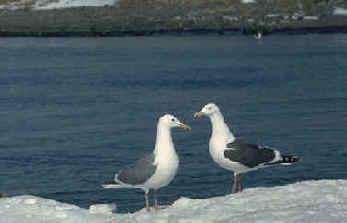
Just two of many gulls
along the Japanese coast.
Vega Gull (left) & Slaty-backed Gull (right)
Some Japanese birders were
looking for Thayer's Gull (at a traditional spot for it). They hadn't
found it when we spoke with them (in a little English and a little Japanese),
but they did tell us of a Black-faced Spoonbill on the other side of the
river. We thanked them and went to the said-spot hoping to see the rare bird.
And that we did. The Black-faced Spoonbill is one of the rarest birds in
the world. It's total population is said to be under 700 birds that breed
locally in Korea and China. Every year some winter in Japan, usually in the
southern part of country. We've seen it during our winter tours previously in
Kyushu, Okinawa, and Amami (1 bird once on the last of these). This was the
first time (in 17 winter tours) that we saw the bird in Honshu.
Our afternoon at the fishing port ended by a sheltered cove, where we watched grebes
and cormorants fishing in the clear water beneath us. The Cormorants
were the Japanese (or Temminck's). The Grebes were of 3
species: Great Crested, Red-necked, and Horned. The small fish in
the water there were plentiful. Oh yes, there were ducks there, too. Ducks,
of a number of species, are also plentiful in the winter in Japan.
The next day we were in a completely different world. We were still on Honshu,
but we had driven just over 2 hours to an area of forested hills. We spent the
night in wonderful little hotel in the forest, with a Japanese hot bath (or
onsen). As the day began, outside the window as we had breakfast, birds were at
the feeders. Some light snow was falling. It was, simply put, a beautiful
setting (and, as noted, one almost wouldn't believe that in this woods we were
just a short drive from the sprawl of Tokyo). Among the birds at the feeders,
there were a number of Japanese Grosbeaks and some Varied Tits.
Stepping outside, when we'd put seeds into the palms, the Varied Tits
would land on our hands to have their breakfast.
At another feeding station nearby, with not only feeders with seed and suet,
there was some open water, much like a spring. There we were treated to good
looks of the endemic Japanese Accentor, the Northern (or Winter)
Wren, and the Yellow-throated Bunting by the water, in addition to
the regular cast of characters including an assortment of tits, nuthatch,
woodpeckers, and finches.
Between the two sets of feeders, out in the woods, a stream with open water
flowed where otherwise there was snow on the ground and the trees were bare.
From along the edge of that stream, a Solitary Snipe flew up into the
sky. That species winters at such spots in the forested hills of Japan. Alone,
as it is, after all, the Solitary Snipe. This one bird was the first for us
(again, in 17 tours in the winter). The species is not in Japan outside the
winter, as it breeds in places such as Siberia and Manchuria, not alone but only
in pairs spread out with nests in remote locations. Ours was a nice bird to see.
In the stream itself, there were Brown Dippers in the water, also nice to
see. The Brown Dipper of eastern Asia, Cinclus pallasii, is named after Peter
Simon Pallas, who lived from 1741 to 1811. He was the most eminent
explorer-naturalist of his day. One of his journeys was a 6-year expedition
(1768-74) across Russia, east from St, Petersburg to Lake Baikal and beyond. One
can wonder if he ever encountered the Solitary Snipe where it breeds in that
remote region "beyond".
During our time in hilly, central Honshu, there were a couple other notable
sightings. Late in the afternoon, as it was getting a bit foggy, a Ural Owl
flew in front of us as traveled along a road. It was seen nicely, but it would
been good if we could have found nearby perched in a tree.
The next morning, when there was a bright blue sky, the treelimbs in the forest were
covered with a layer of snow. It was a beautiful morning, which could have been
better with just one thing. We were trying, before we had to leave the area, to
see a bird that's always at or near the top of the "most-wanted list"
for most birders visiting Japan. The bird: the endemic Copper Pheasant.
On the fresh snow, at the edge of a side-road, we saw fresh tracks. And, then,
shortly later, near that spot, it was as good as it gets when a male Copper
Pheasant walked out in front of us, as we sat in our vehicle. For a while, the
bird stood still, and thus, we got a long look at that exquisite bird with the
long tail! Yes. it was as good as it gets.
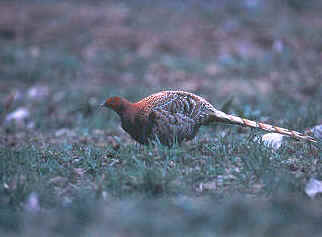
A male Copper Pheasant
The birds noted so far (after
the first paragraph) were all on Honshu, where, yes, as it's been said, the
birding can be "extraordinarily good". But, really, during our Japan
Winter Tours, it's the birds of Hokkaido and
Kyushu that normally get the top-billing -
the cranes, the eagles, and the Blakiston's Fish-Owl.
To go from Honshu to Hokkaido, we have, over
the years, taken an overnight ferry as a pelagic trip on the Pacific. And that
we did again in January '07. The ferry is a large boat, on which after boarding
we sleep, and then all-day offshore we can scan the sea for birds. We were this
time as the boat has a good, big enclosed area in the front end of the boat,
from which we could see the sea ahead of us.
In recent years, for whatever reason, we have not been seeing, during this trip,
as many Laysan Albatrosses as we did in the past. In '07, however, that
trend was reversed. Maybe it was because we could watch ahead of us continuously
in comfort, but this time we saw about 50 Laysan Albatrosses flying in
their distinctive style above the water.
And having the good area for observation certainly enabled us to see alcids
better than usual (as it's always better to observe them in front of the boat).
From our vantage point on the ferry, as we headed north, offshore from Honshu,
and continuing into colder waters, the alcids we saw were: Common
Murre, Thick-billed Murre, Spectacled Guillemot, Pigeon Guillemot, Long-billed
Murrelet, Ancient Murrelet, and Least Auklet. Most of these we
saw in rather large numbers.
Hokkaido in January is a land of winter. It always has been for us, although
January 2007 was warmer than usual. From eastern Hokkaido, there's a boat-trip
that goes to the edge of the oceanic ice. It's a good way to see more alcids (which
we did) on the water, while on the ice, Steller's Sea-Eagles and possibly
other interesting birds can be seen. This year, the ice was too far from shore,
so 1) the boat didn't go to it, 2) the trip cost a little less, but 3) we did
see alcids again nicely on the water, particularly with good looks of the
Spectacled Guillemot, a species that's rather restricted to the Sea of
Okhotsk and comparable waters of northeast Asia.
Back onshore, along the eastern coast of Hokkaido, we were treated to flocks of
colorful Harlequin Ducks, other Ducks including Falcated,
Glaucous Gulls (usually very common in eastern Hokkaido), an Iceland Gull
(rare in Japan), a Gyrfalcon that caused a swarm of gulls to fly
into the air as it flew by, and the stars of the show, the Eagles - one
of those stars is even called "Steller". Both the Steller's
Sea-Eagles and the White-tailed Eagles were seen nicely and in good
numbers during our tour.
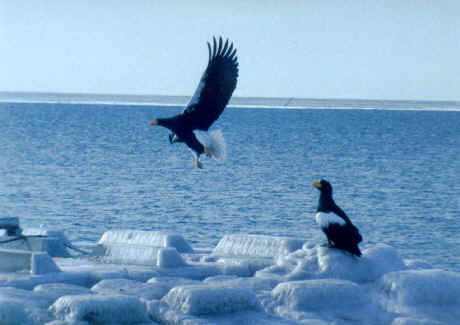
Steller's Sea-Eagles in
eastern Hokkaido
In January '07, along the
eastern Hokkaido coast, we saw a small and colorful bird that we don't normally
see on Hokkaido in the winter: a male Daurian Redstart. Usually we see it
further south. So, this time, we saw this species that only winters in Japan, on
all 4 of the islands that we visited (north to south: Hokkaido, Honshu, Kyushu,
and Amami).
During all of our 16 previous Winter Japan Birding Tours, we've seen the Blakiston's
Fish-Owl. Localized in Japan only in Hokkaido, it is one of the world's
rarest owls. (Occurring also in the wilderness of eastern Siberia, it's far from
plentiful there also - in that land where the Siberian Tiger lives.) It's
exciting to see the Blakiston's not only because it's rare, but also because
it's huge, being one of the largest of the world's owls. At dusk, we were at the
right spot. We heard first the deep call of the bird. Then, with their large
wingspans, two of them flew in to perch in trees near us! For FONT, it was the
Blakiston's Fish-Owl for the 17th time.
In the town where we spent a couple nights in eastern Hokkaido, there are some
shops where local people sell woodcarvings that they've made of the
Blakiston's Fish-Owl. After seeing the owl in life, it was nice to see (and buy)
the woodwork in the store. Being in Hokkaido is such a great experience, so far
away from the world in which most of us live.
Down the road, from the town with the shops, the Hokkaido experience is
reinforced in the morning, as Whooper Swans swim and call enshrouded by
mist in the waters of a big lake. Those noisy Whoopers are only in Hokkaido
during the winter. When Hokkaido warms up, they go north to Siberia, where they
breed.
The Red-crowned Cranes in Hokkaido, also vocal, are there, however,
throughout the year. They don't leave. In the winter, however, they flock up
together at certain places, where watching them is one of a birder's highlights
of a lifetime. Also known as Japanese Cranes, these tall stately birds
can be seen in the winter, against a beautiful snowy background, jumping into
the air, and can be heard making their bugle-like sounds. In the first half of
the 20th Century, that sound nearly became silenced when the species in Japan
flirted with extinction. It was nearly as rare as the Whooping Crane of North
America. How great it is that both species were not lost, when really they very
well could have been. Today, there are about 900 Red-crowned (or Japanese)
Cranes in Hokkaido (the only place in Japan where they occur). We saw at one
place more than 200 of them.
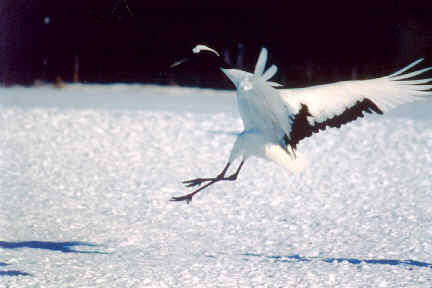
Red-crowned (or Japanese)
Crane
Seeing the cranes in
Japan is of course a wonderful experience, but it can enhanced by the reading of
a book, published not that long ago in 2001, "The Birds of Heaven - Travels
with Cranes", by Peter Matthiessen. There's a chapter in that well-written
book about the Red-crowned Cranes in Hokkaido.
As good as it is that now there are nearly a thousand cranes in Hokkaido,
in Kyushu during the winter, there are about
7,000. They come to one particular area there every year from mainland Asia,
where in the summer their nesting area is spread across many miles of mostly
Siberia. In the winter, however, they come to be together in a large grouping of
about 5,000 Hooded Cranes and 2,000 White-naped Cranes. Adults and
young of the year are seen together, among the large flocks.
For years, we've come, from other parts of the world, to see these birds. Again,
as with the cranes on Hokkaido, it's quite an experience. Every year, a few
cranes of other species are also in the flocks. Every year, we've seen Common
Cranes and Sandhill Cranes, as we did again in January '07. Some
years, there have been Siberian Crane and Demoiselle Crane. During
the 2006-07 winter, birds of those 2 species were not in Japan.
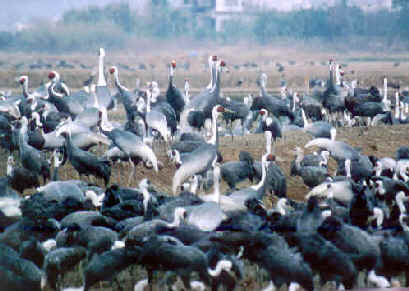
Hooded & White-naped
Cranes in Kyushu
Cranes are not the only
birds that come to Kyushu, Japan from mainland Asia to spend the winter. Not far
from the cranes, we saw some small birds in the reeds that did the same thing: Chinese
Penduline Tits and Pallas's Reed Bunting (another Asian bird named
after Peter Simon Pallas). Having done the same type of journey were the Daurian
Jackdaws that we saw mixed in among the Rooks (also from mainland
Asia) on the telephone wires. The Northern Lapwings and Temminck's
Stints that we saw on the fields did the same thing. They, too, are only in
Japan during the winter.
The cranes that winter in Kyushu are well-known in ornithological
circles. Not as well known, in Kyushu in the winter are the large flocks of Mandarin
Ducks present there only during that season. They are on the other side of
Kyushu. We enjoy seeing them along a particular river in a valley surrounded by
forested hills. During a day, we see at least a couple thousand of these
beautiful ducks, with different colors but otherwise similar to the Wood Duck of
North America. The Mandarins that winter in Kyushu are shy. The flocks fly up
quickly from the aqua-blue water of the river. In a telescope, and with
binoculars, observing the large number of Mandarins is yet another wonderful
Japanese experience.
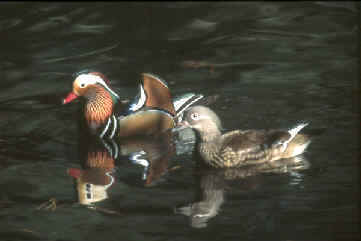
Male & female
Mandarins
In January 2007, as we were having this experience, 2 Mountain Hawk-Eagles were soaring in circles overhead above the forested hills. Not far away that day, on the ground, there were Olive Tree Pipits walking about, and a White's Ground Thrush feeding. In trees, nearby, Japanese Grosbeaks were doing the same, eating berries. By a temple, during our time in Kyushu, there was more activity in trees as Japanese Macaques, also known as "Snow Monkeys" were moving about.
We had so many wonderful experiences during our January 2007 Winter Tour in Japan.
Link:
Upcoming
FONT Japan Tours
Top
of page
![]()
FONT E-News,
Volume 8, No. 1
February 4, 2007
from Focus On Nature Tours, Inc.
"Our "06-'07 FONT Annual Holiday Tour in Guatemala"
Often as we walked in the area of Tikal,
there were birds in the trees. Many were small; some were large. Among the
biggest was a single CRESTED GUAN that stayed there, somewhat clumsily moving
about, above us.
Not as large as a guan, but big enough, another bird was a bit more adept as it
moved about in a tree. It was the SQUIRREL CUCKOO, moving a bit as it did rather
like a squirrel.
And last on that first list was the CROCODILE. It was big, very big, across the
way on the bank of a pond. Its mouth was wide open, and let me say, we didn't
need our binoculars to see its teeth.
On another person's list, number #1 was the PINK-HEADED WARBLER. And deservedly
so. It's a brilliant bird, mostly red, with a frosty head, living in the pines
and oaks of the Guatemalan mountains.
Number #2 was the ORNATE HAWK-EAGLE. One morning as we were on a high slope of a
volcano, 2 of them flew by above us, one after the other. The species was the
second Hawk-Eagle of the morning for us. We had just seen the BLACK-AND-WHITE.
We were just about to see the BLACK. Incredible it was to encounter 3 species of
HAWK-EAGLES in just a couple hours.
Another morning as we were traveling in the northern Guatemalan region called
the Peten, not really near anything, there was in the sky ahead of us, a large
kettle of big birds lifting up in a thermal. We stopped and looked up. They were
WOOD STORKS, about a hundred of them, soaring in circles. It was a truly nice
sight.
Next on the was the BLACK-AND-WHITE HAWK-EAGLE mentioned a moment ago. We had
such a good look at that marvelous raptor.
During the tour we were never along the seacoast, the haunt of the BROWN
PELICAN. So we didn't really expect to see them. But twice we did in the remote
Peten. Once, along a river, where it widened into almost a lake, they sat on the
water, 6 of them. Another day, by the edge of what was a large lake, we saw a
bigger group of those large birds, in flight. There were 17 of them, like a
squadron, as they passed by. Also in that area, by the way, was another bird
usually by the sea, a ROYAL TERN. And interesting also, there was a single
LESSER BLACK-BACKED GULL with the LAUGHING GULLS on pilings. During the FONT
tour there, 2 years ago, we saw one LESSER BLACK-BACKED GULL.
Did I mention that when we were on that slope of the volcano, where we saw the
HAWK-EAGLES, there was an EARTHQUAKE? Well, there was. It was a mild one, but it
made the list of favorite things of the trip.
The SQUIRREL CUCKOO got another vote. Also getting votes were the KEEL-BILLED
TOUCAN and the MONTEZUMA OROPENDOLA. It's not hard to understand why. Both were
fun to watch, and the oropendola, also, fun to hear.
Then there was the pair of ORANGE-BREASTED FALCONS at Tikal. One perched high in
a tree. Another called nearby. ORANGE-BREASTED FALCONS have been seen during
FONT tours at Tikal in 2002, 2004, 2005, 2006, and now, 2007. Probably no where
can they more readily seen than at Tikal.
Another trogon got a vote, the MOUNTAIN TROGON. Yes, it's a bird of the
mountains, and a nice one at that.
The MONKEYS got another vote. The IGUANA was not forgotten. And the OWL
BUTTERFLY that we saw so nicely along a forest trail was not only not forgotten.
It was very well remembered. Photos of it, and a number of the other
vote-getters that we've mentioned here, are elsewhere in this website (the link
precedes this narrative).
Let me, if I may, give my "Top Ten" of the tour, before concluding.
All of them, of course, are birds:
* the 3 species of HAWK-EAGLES during 1 morning
* the ORANGE-BREASTED FALCON
* an ANT SWARM with a frenzy of birds including: various WOODCREEPERS,
GRAY-HEADED TANAGER, GRAY-THROATED CHAT, and others
* the PINK-HEADED WARBLER
* the BLUE-THROATED SAPPHIRE (a nice hummingbird in the forest; during the tour
there were over 15 species of hummingbirds)
* the PREVOST'S GROUND-SPARROW (a truly dapper bird!)
* the CHESTNUT-COLORED WOODPECKER (we saw it so well; it was so nice to see)
* HOODED WARBLERS (even though they're in our North American woodlands in the
summer, they're always nice to see! - as were the many WOOD THRUSHES we saw at
Tikal)
* the WOOD STORKS in the large kettle already mentioned
and lastly,
* the VERMILION FLYCATCHER. In a Spanish-speaking country, I like to call the
brilliantly-red male the "brazito de fuego", "that little ball of
fire".
Also in terms of color, it's deserves mentioning that we saw 7 bright species of
ORIOLES during the tour.
There were 260 species of other birds, as the total for the trip was 267.
Guatemala has been the destination for a number of years now for our annual
December/January Holiday Tour. Years ago, we went, for a number of years, over
the holidays, to Costa Rica. We've also done Dec/Jan Holiday Tours in southern
Spain and in the Caribbean, in the Dominican Republic and in the Lesser
Antilles.
Link:
![]()